Preface
The Open Group
The Open Group is a global consortium that enables the achievement of business objectives through technology standards. With more than 870 member organizations, we have a diverse membership that spans all sectors of the technology community – customers, systems and solutions suppliers, tool vendors, integrators and consultants, as well as academics and researchers.
The mission of The Open Group is to drive the creation of Boundaryless Information Flow™ achieved by:
- Working with customers to capture, understand, and address current and emerging requirements, establish policies, and share best practices
- Working with suppliers, consortia, and standards bodies to develop consensus and facilitate interoperability, to evolve and integrate specifications and open source technologies
- Offering a comprehensive set of services to enhance the operational efficiency of consortia
- Developing and operating the industry’s premier certification service and encouraging procurement of certified products
Further information on The Open Group is available at www.opengroup.org.
The Open Group publishes a wide range of technical documentation, most of which is focused on development of Standards and Guides, but which also includes white papers, technical studies, certification and testing documentation, and business titles. Full details and a catalog are available at www.opengroup.org/library.
The TOGAF® Standard, a Standard of The Open Group
The TOGAF Standard is a proven enterprise methodology and framework used by the world’s leading organizations to improve business efficiency.
This Document
This document is a TOGAF® Series Guide: Government Reference Model (GRM). It has been developed and approved by The Open Group.
More information is available, along with a number of tools, guides, and other resources, at www.opengroup.org/architecture.
About the TOGAF® Series Guides
The TOGAF® Series Guides contain guidance on how to use the TOGAF Standard and how to adapt it to fulfill specific needs.
The TOGAF® Series Guides are expected to be the most rapidly developing part of the TOGAF Standard and are positioned as the guidance part of the standard. While the TOGAF Fundamental Content is expected to be long-lived and stable, guidance on the use of the TOGAF Standard can be industry, architectural style, purpose, and problem-specific. For example, the stakeholders, concerns, views, and supporting models required to support the transformation of an extended enterprise may be significantly different than those used to support the transition of an in-house IT environment to the cloud; both will use the Architecture Development Method (ADM), start with an Architecture Vision, and develop a Target Architecture on the way to an Implementation and Migration Plan. The TOGAF Fundamental Content remains the essential scaffolding across industry, domain, and style.
Trademarks
ArchiMate, DirecNet, Making Standards Work, Open O logo, Open O and Check Certification logo, Platform 3.0, The Open Group, TOGAF, UNIX, UNIXWARE, and the Open Brand X logo are registered trademarks and Boundaryless Information Flow, Build with Integrity Buy with Confidence, Commercial Aviation Reference Architecture, Dependability Through Assuredness, Digital Practitioner Body of Knowledge, DPBoK, EMMM, FACE, the FACE logo, FHIM Profile Builder, the FHIM logo, FPB, Future Airborne Capability Environment, IT4IT, the IT4IT logo, O-AA, O-DEF, O-HERA, O-PAS, Open Agile Architecture, Open FAIR, Open Footprint, Open Process Automation, Open Subsurface Data Universe, Open Trusted Technology Provider, OSDU, Sensor Integration Simplified, SOSA, and the SOSA logo are trademarks of The Open Group.
All other brands, company, and product names are used for identification purposes only and may be trademarks that are the sole property of their respective owners.
About the Authors
(Please note affiliations were current at the time of approval.)
Mick Adams, EY
Mick Adams is Co-Chair of The Open Group Architecture Forum and a Distinguished Profession Leader within The Open Group Open CA certification program. He is a key author of numerous “World-Class Enterprise Architecture” papers and was a key contributor to the TOGAF® 9 Standard. Based in Europe, he is part of EY’s Global Architecture Leadership Team and works in a variety of industries including financial services, oil & gas, and the public sector, helping clients to solve challenging business issues with the help of technology.
Chris A. Brown, EY
Chris has many years’ experience helping organizations achieve their strategic objectives to align IT services to business processes. He has depth of experience delivering large-scale Digital Transformation programs utilizing TOGAF methodologies. Originally from Australia, Chris has worked across public and private sectors there and for the past 15 years in the UK, working across sectors but with particular focus in central government departments as well as energy, utilities, and infrastructure markets.
Michael Chambers, EY
Michael Chambers is a Management Consultant with many years’ expertise in Business and Enterprise Architecture. He has helped organizations achieve their goals and ambitions with clear alignment of technology to strategy using the TOGAF® Standard. He has architecture and transformation experience in both private and public sectors, including higher education, legal & regulatory, media, telecommunications, and local/central government services.
Jaisinh S. Dhembre, EY
Jaisinh Dhembre (JD) is an accomplished business and IT executive with more than two decades of global experience in helping organizations achieve their business goals through digital and technology transformation. A strong proponent of the business outcome-driven architecture mindset, JD is a TOGAF® 9 Certified Architect and has been involved in different Forums and Work Groups including the Architecture Forum, the Digital Practitioners Work Group, the IoT Work Group, and the SOA Work Group. He was also part of the team that contributed towards the TOGAF Standard, Version 9. JD also helps manage the EY membership and relationship with The Open Group. Based in the US, with his wife and two daughters, JD is part of EY’s Technology Transformation Leadership Team and works closely with organizations across the globe and from various industry sectors.
Jeremy Giles, Ministry of Defence
Lieutenant Colonel Jeremy (Jes) Giles is currently responsible for coherence across the British Army’s future collective training capability requirements. He also advises the Army’s Service Command Technical Authority (SCTA) for Defence Modelling and Simulation Coherence (DMaSC). His career to date has balanced being an operationally-focused infantry officer, serving in Iraq, Afghanistan, and elsewhere, with staff experience managing Army training simulation capability in Sponsor, User, and Delivery Agent roles.
Priya Mistry, EY
Priya Mistry is a TOGAF® 9 Certified Professional and specializes in Business Architecture and IT Transformation. Based in the UK, she uses Business Architecture to help IT organization leaders to design transformation programs and manage technology change to support enterprise goals and objectives. She has industry experience in defense, public sector, and telecommunications.
Clemence Monsaingeon, EY
Clemence Monsaingeon is a consultant helping organizations improve their processes and achieve objectives by leveraging technology. Based in the UK, she has experience working with global organizations within their finance, operations, and commerce functions.
Acknowledgements
(Please note affiliations were current at the time of approval.)
The Open Group gratefully acknowledges the authors and the following reviewers who participated in the Company Review of this document:
- Christopher Carlson, CT Carlson LLC
- David Gilmour, Mundo Congnito
- Sonia Gonzalez, The Open Group
Referenced Documents
The following documents were used in the development of this TOGAF® Series Guide:
- ACCA (2016): 50 Drivers of Change in the Public Sector; retrieved from ACCA: https://www.accaglobal.com/content/dam/ACCA_Global/Technical/Future/drivers-of-change-in-the-public-sector.pdf
- Agency for Healthcare Research and Quality (2018, November): EvidenceNow Key Drivers and Change Strategies; retrieved from Agency for Healthcare Research and Quality: https://www.ahrq.gov/evidencenow/tools/keydrivers/description.html
- Allcock, C., Dormon, F., Taunt, R., Dixon, J. (2015): Constructive Comfort: Accelerating Change in the NHS, London: The Health Foundation; retrieved from: http://www.health.org.uk/sites/default/files/ConstructiveComfortAcceleratingChangeInTheNHS.pdf
- Australian Government Department of Defence (2020, July 1): 2020 Defence Strategic Update & 2020 Force Structure Plan; retrieved from Australian Government Department of Defence: https://www1.defence.gov.au/strategy-policy/strategic-update-2020
- Benini, L., Viaud, V. (2020): Drivers of Change of Relevance for Europe’s Environment and Sustainability, Luxembourg: European Environment Agency, doi:10.2800/129404
- Brooks, K. (2018, August 31): How Robots are Changing the Defence Sector; retrieved from Current: https://www.distrelec.de/current/en/robotics/how-robots-are-changing-the-defence-sector/
- Byrom, N., Beardon, S., Kendrick, A. (2020, May): The Impact of COVID-19 Measures on the Civil Justice System, Guildford: The Legal Education Foundation; retrieved from: https://www.judiciary.uk/wp-content/uploads/2020/06/CJC-Rapid-Review-Final-Report-f.pdf
- Case, S., Hampson, K. (2019): Youth Justice Pathways to Change: Drivers, Challenges, and Opportunities, Youth Justice, 19(1), 25-41, doi:10.1177/1473225418822166
- Dahl-Østergaard, T., Unsworth, S., Robinson, M., Jensen, R.I. (2005, September): Lessons Learned on the Use of Power and Drivers of Change Analyses in Development Co-operation, OECD DAC Network on Governance; retrieved from: https://www.oecd.org/dac/conflict-fragility-resilience/governance/docs/37957900.pdf
- Davies, T. (2020, April 28): Councils versus Coronavirus: The Future Starts Now; retrieved from The MJ.co.uk: https://www.themj.co.uk/Councils-vs-coronavirus-the-future-starts-now/217410#
- Deloitte (2012): How Disruptive Innovation can Help Government Achieve More for Less, Deloitte; retrieved from: https://www2.deloitte.com/content/dam/Deloitte/global/Documents/Public-Sector/dttl-ps-publicsectordisrupted-08082013.pdf
- Department of Health (2015, June 3): Innovation and Transformation are Key Drivers to Reforming Health and Social Care – Hamilton; retrieved from Department of Health: https://www.health-ni.gov.uk/news/innovation-and-transformation-are-key-drivers-reforming-health-and-social-care-hamilton
- DMC Canotec (2018): Driving Digital Change in Education; retrieved from DMC Canotec: https://www.dmcplc.co.uk/driving-digital-change-in-education/
- Drivers of Change Faced by the Transit Industry (2012) in T. Henkin, R. Padgette, S. Knapp, E. Fetting, S. Baker, R.G. Stanley, Transforming Public Transportation Institutional and Business Models (pp.15-18), Washington, DC: National Academy of Sciences; retrieved from: https://www.nap.edu/read/22675/chapter/5
- European Monitoring Centre on Change (2008): Trends and Drivers of Change in the EU Transport and Logistics Sector, Mapping Report, Dublin: European Foundation for the Improvement of Living and Working Conditions; retrieved from: http://projects.mcrit.com/foresightlibrary/attachments/Trends%20and%20drivers%20of%20change%20in%20the%20EU%20transport%20and%20logistics%20sector%20Mapping%20report.pdf
- EY (2018): National Security and Defense; retrieved from Government & Public Sector : https://sites.ey.com/sites/DS_GPS/Pages/defense.aspx
- EY (2020): Understanding Megatrends will Help you See Opportunities Where Others Don’t; retrieved from EY Megatrends: https://www.ey.com/en_gl/megatrends
- Front Office Shared Services (2008): Managing Transformation, London: Improvement and Development Agency; retrieved from: https://www.local.gov.uk/sites/default/files/documents/managing-transformation-p-191.pdf
- Government Enterprise Architecture (2018, March): Business Reference Taxonomy; retrieved from New Zealand Government: https://snapshot.ict.govt.nz/resources/digital-ict-archive/static/localhost_8000/assets/Architecture/GEA-NZ-Framework/GEA-NZ-v3.2-Business-Reference-Taxonomy-2018-March.pdf
- Government Finance Function (2019): Government Finance Function Strategy 2019-2023, OneFinance; retrieved from: https://assets.publishing.service.gov.uk/government/uploads/system/uploads/attachment_data/file/815636/6.5637_GFA_Strategy-Document_full_v20_web.pdf
- Government of Jersey (2020): Business Plan Growth, Housing, and Environment, Government of Jersey Communications Team; retrieved from: https://www.gov.je/SiteCollectionDocuments/Government%20and%20administration/ID%20Business-Plan%20GHE.pdf
- Guijosa, C. (2018, December 5): The Five Drivers that will Influence the Future of Education, According to KnowledgeWorks; retrieved from Observatory of Educational Innovation: https://observatory.tec.mx/edu-news/the-five-drivers-that-will-influence-the-future-of-education-according-to-knowledgeworks
- Ham, C., Dixon, A., Brooke, B. (2012): Transforming the Delivery of Health and Social Care, London: The King’s Fund; retrieved from: https://www.kingsfund.org.uk/sites/default/files/field/field_publication_file/transforming-the-delivery-of-health-and-social-care-the-kings-fund-sep-2012.pdf
- Higgs, P., Gilleard, C. (2015): Key Social and Cultural Drivers of Changes Affecting Trends in Attitudes and Behaviour Throughout the Ageing Process and What they Mean for Policy-making, London: Government Office for Science; retrieved from: https://assets.publishing.service.gov.uk/government/uploads/system/uploads/attachment_data/file/454711/gs-15-14-future-ageing-attitudes-social-cultural-er05.pdf
- HM Courts & Tribunals Service (2019), HMCTS Business Plan 2019-2020, London: HM Courts & Tribunals Service; retrieved from: https://assets.publishing.service.gov.uk/government/uploads/system/uploads/attachment_data/file/819783/HMCTS148_Business_Plan_2019_A4P_External_RGB.PDF
- ICAEW (2021, February 8): Coronavirus and the Public Sector; retrieved from ICAEW: https://www.icaew.com/coronavirus/public-sector
- ICAEW (2021, February 9): Trust in International Public Finances Needs to be Rebuilt Following the Pandemic; retrieved from ICAEW: https://www.icaew.com/insights/viewpoints-on-the-news/2021/feb-2021/trust-in-international-public-finances-needs-to-be-rebuilt-following-the-pandemic
- John Borton Consulting (2009, November): Future of the Humanitarian System; retrieved from Humanitarian Futures Organisation: https://www.humanitarianfutures.org/wp-content/uploads/2013/06/2009-Future-of-the-Humanitarian-system-impact-of-internal-changes.pdf
- Lewis, J.M., Ricard, L.M., Klijn, E.H. (2017, July 11): How Innovation Drivers, Networking and Leadership Shape Public Sector Innovation Capacity, International Review of Administrative Sciences, 84(2), 288-307, doi:10.1177/0020852317694085
- Lineberger, R. (2019): 2020 Global Aerospace and Defense Industry Outlook; retrieved from Deloitte: https://www2.deloitte.com/global/en/pages/manufacturing/articles/global-a-and-d-outlook.html
- Local Government Association (2021): Transformation; retrieved from Local Government Association: https://www.local.gov.uk/our-support/guidance-and-resources/transformation
- Martinez, J.A. (2017): Main Drivers in the Supply Chain; retrieved from BDP International: https://www.bdpinternational.com/blog/main-drivers-in-the-supply-chain
- Metcalfe, A. (2019, September 11): Innovation in Public Finance; retrieved from ACCA: https://www.accaglobal.com/gb/en/professional-insights/pro-accountants-the-future/innovation_in_public_finance.html
- Ministry of Defence (2018): Mobilising, Modernising, and Transforming Defence; retrieved from gov.uk: https://assets.publishing.service.gov.uk/government/uploads/system/uploads/attachment_data/file/931705/ModernisingDefenceProgramme_report_2018_FINAL.pdf
- Ministry of Housing, Communities, and Local Government (2020): Planning for the Future, London: Ministry of Housing, Communities, and Local Government; retrieved from: https://assets.publishing.service.gov.uk/government/uploads/system/uploads/attachment_data/file/958420/MHCLG-Planning-Consultation.pdf
- Naidoo, V. (2014, December 12): Drivers for Change in Higher Education; retrieved from: http://oasis.col.org/bitstream/handle/11599/673/Drivers-Change-Higher-Education-Transcript.pdf?sequence=1&isAllowed=y
- National Infrastructure Commission (2017, March 3): Economic Growth and Demand for Infrastructure Services; retrieved from gov.uk: https://nic.org.uk/app/uploads/2906219-NIC-Technical-Paper-Economic-Driver-v1_0A-WEBACCESSIBLE-4.pdf
- Niestadt, M., Debyser, A., Scordamaglia, D. (2019): Artificial Intelligence in Transport; retrieved from European Union: https://www.europarl.europa.eu/RegData/etudes/BRIE/2019/635609/EPRS_BRI(2019)635609_EN.pdf
- Nurjono, M., Yoong, J., Yap, P., Wee, S.L., Johannes, H., Vrijhoef, M. (2018, October 16): Implementation of Integrated Care in Singapore: A Complex Adaptive System Perspective, International Journal of Integrated Care, 18(4), 1-7, doi:10.5334/ijic.4174
- Obama White House (2013, May 15): Business Reference Model Taxonomy with Definitions; retrieved from Obama White House Archives: https://obamawhitehouse.archives.gov/sites/default/files/omb/assets/egov_docs/brm_v3-1_taxonomy_20130615.pdf
- OECD (2003): Managing the Fundamental Drives of Transport Demand, Paris: OECD Publications; retrieved from: https://www.itf-oecd.org/sites/default/files/docs/03demand.pdf
- O’Hanlon, M.E. (2018, September): Forecasting Change in Military Technology, 2020-2040; retrieved from Brookings: https://www.brookings.edu/research/forecasting-change-in-military-technology-2020-2040/
- Orlik, T., Johnson, S., Tanzi, A. (2019, October 29): Tracking the Forces Threatening the World’s Hottest Economies; retrieved from Bloomberg: https://www.bloomberg.com/graphics/2019-new-economy-drivers-and-disrupters/
- Page, L. (2020, September 7): Tech Start-ups Join Battle to Modernise Army for an Era of Drone Swarms and Robots; retrieved from The Telegraph: https://www.telegraph.co.uk/technology/2020/09/07/ai-start-ups-join-fight-change-militarys-ways/
- PricewaterhouseCoopers (2005): The Defence Industry in the 21st Century; retrieved from pwc.pl: https://www.pwc.pl/en/publikacje/defence_industry_ads.pdf
- Redecker, C., Leis, M., Leendertse, M., Punie, Y., Gijsbers, G., Kirschner, P., Hoogveld, B. (2011): The Future of Learning: Preparing for Change, Luxembourg: Publications Office of the European Union; retrieved from JRC European Commission: https://www.researchgate.net/publication/256461836_The_Future_of_Learning_Preparing_for_Change
- Reid, J., Johnson, A., Browne, D., Drayson, L., Michael, A. (2005, December): Defence Industrial Strategy retrieved from gov.uk: https://assets.publishing.service.gov.uk/government/uploads/system/uploads/attachment_data/file/272203/6697.pdf
- Ryley, K., Allison, K., Hegarty, J., Wain, J., Cook, G., Doyle, G., Bradbury, P. (2018, September): Transformational Change is Front and Foremost of Future Local Authority Service Delivery; retrieved from CIVICA: https://www.civica.com/en-gb/campaign-library-uk/2018/september/changing-landscape-for-local-government/
- Sandschneider, E. (2017): Drivers of Global Change, Berlin: American Academy in Berlin; retrieved from: https://www.americanacademy.de/drivers-global-change/
- Shared Services: Digitized and Disrupted (2020, January 16); retrieved from SSON: https://www.ssonetwork.com/business-process-outsourcing/articles/shared-services-digitized-and-disrupted
- Spies, M. (2019, July 10): What are the Drivers and Innovations Shaping Tomorrow’s Higher Education Landscape?; retrieved from FutureLearn: https://www.futurelearn.com/info/press/research-insights/what-are-the-drivers-and-innovations-shaping-tomorrows-higher-education-landscape
- Stacey, N., Ellwood, P., Bradbrook, S., Reynolds, J., Williams, H. (2017): Key Trends and Drivers of Change in Information and Communication Technologies and Work Location, Luxembourg: European Agency for Safety and Health at Work, doi:10.2802/807562
- The NHS Confederation (2013): Changing Care, Improving Quality, London: The NHS Confederation; retrieved from: https://www.nhsconfed.org/-/media/Confederation/Files/Publications/Documents/Changing-care-improving-quality.pdf
- Trendall, S. (2020, June 5): How Can Local Government Get it Right on Shared Services?; retrieved from Public Technology: https://www.publictechnology.net/articles/features/how-can-local-government-get-it-right-shared-services
- Tucker, R. (2018, January 25): Six Driving Forces of Change that Will Shape 2019 and Beyond; retrieved from Forbes: https://www.forbes.com/sites/robertbtucker/2019/01/25/six-driving-forces-of-change-that-will-shape-2019-and-beyond/?sh=2b3000e1107a
- UNESCO International Standard Classification of Education (ISCED); refer to: http://uis.unesco.org/en/topic/international-standard-classification-education-isced
- Viens, A. (2019, November 13): An Investing Megatrend: How Demographics and Social Changes are Shaping the Future; retrieved from Visual Capitalist: https://www.visualcapitalist.com/investing-megatrend-how-demographics-social-changes-shape-the-future/
- Zuckerman, S., Campbell Wilcox, K., Durand, F.T., Lawson, H.A., Schiller, K.S. (2017, November): Drivers for Change: A Study of Distributed Leadership and Performance Adaptation During Policy Innovation Implementation, Leadership and Policy in Schools, 1-29. doi:10.1080/15700763.2017.1384500
The Business Architecture defines the business strategy, governance, organization, business information, and key business processes of an Enterprise Architecture. An architecture approach determines how to effect change within the appropriate cost, benefit, and risk parameters.
A challenge to this approach arises due to a lack of consistency in the application of architecture standards used to inform Business Architects or those intending to develop a Business Architecture or technical solution on the expected Architecture Building Blocks (ABBs) for governments worldwide.
The Government Reference Model (GRM) gives public sector organizations a common way to view themselves in order to plan and execute effective transformational change.
1.1 Objective
The objective of this document is to specify a standard reference model template that can be used to describe any business in the public sector and allow for different architecture approaches and analysis techniques. This model supports collaboration between architecture service providers and enables the development of the Business Architecture profession.
1.2 Overview
The GRM is used to categorize and segment operational departments in order to operate an effective architecture function. This model facilitates the ability to determine the impact of change to the estate and to map dependencies between the architecture layers.
This document provides direction that organizations need in order to develop Business Architecture assets that will help public sector decision-makers to resolve business issues, manage business and technology change, and plan for future change.
The GRM can be used out-of-the-box, extended, or customized to represent the organization based on its unique characteristics and the specific requirements at hand.
1.3 What is the Government Reference Model?
The GRM is an exhaustive and mutually-exclusive reference model for the public sector. This model provides a categorization of terminology to describe the Business Architecture which can be leveraged as a framework across all governments.
The GRM assumes the application estate for the government is split across the following departments:
- International Affairs and Trade
- Defense and Security
- General Government and Local Services
- Young People and Education
- Health and Community Wellbeing
- Judiciary, Justice, and Home Affairs
- Financial
- Growth, Housing, and Environment
- Policy, Performance, Population, and Innovation
- Shared Services
- Transport and Operations
Table 1 shows the names and description of various types of sectors that are in the GRM.
Table 1: Sectors and Descriptions
|
Sector |
Definition |
|
International Affairs and Trade |
Activities undertaken by the government to facilitate financial support and trade with international economies and related to the conduct and implementation of policies, aid programs, treaties, and diplomatic relations. |
|
Defense and Security |
Corresponds to the research, maintenance, equipment, procurement, and development of forces, weapons, and related entities. This also comprises remuneration and benefits paid to all active and non-active civilians and personnel. |
|
General Government (Customer Service, Customer Operations) and Local Services |
The provision of general customer services and operations including registrations, licensing, applications, workforce planning, social services, management of labor rights, and local services. |
|
Young People and Education |
Educational programs that correspond to early years, primary school, secondary school, higher education, and specialist schooling; children’s social services, safeguarding, and associated children and adolescent services; and skill or training activities undertaken by the government to promote education. |
|
Health and Community Wellbeing |
Encompasses medical and nursing governance, strategy and care services provided to individuals and families, research, and the provision of hospital and community services to safeguard mental and physical health. |
|
Judiciary, Justice, and Home Affairs |
Covers the total cost of judiciary, prosecution, expenses connected with funding protection, law enforcement services, and the cost of criminal justice including incarceration, supervision, parole, and rehabilitation of prisoners. |
|
Financial |
Maintains controls over public spending, revenue, financial reporting, auditing, and providing the direction for future investment decisions and financial planning. |
|
Growth, Housing, and Environment |
Activities that ensure natural and urban environment responsibility, provision of core infrastructure, and protection of citizens’ standards of living and safety through the licensing and enforcement of regulation. |
|
Policy, Performance, Population, and Innovation |
Involves the development of policy across the government, the provision of statistics for population and performance against benchmarks to ensure continuous improvement, and incorporates strategic and long-term planning to identify future risks, opportunities, and solutions. |
|
Shared Services |
Co-ordinates and manages people, communications, finance, and transformation services on behalf of the public in order to facilitate the transfer of information and oversight of people, processes, and technology to support procurement and align to corporate strategy. |
|
Transport and Operations |
Activities that enable general operations and guarantee the safe transfer and availability of people and goods over land, air, sea, and space. |
The reference model provides a taxonomy for each service provisioned by the government and a common language that simplifies complex information components, enables consistency of cross-government services and common capabilities, and delivers a consistent view of commonly required operational services.
The intended audience of this GRM includes decision-makers and designers of change in the public sector.
Subsequent sections will go into each of the three levels: Level 1 (Sectors) and the corresponding Level 2 (Functions) and Level 3 (Services). Recommended nomenclature and descriptions for these components are used to provide further detail and context of the organizational units that may be present in a public sector organization. Drivers for change will also be explored for each of the 12 sectors.
Figure 1 provides a view of the structure of each element of the GRM.
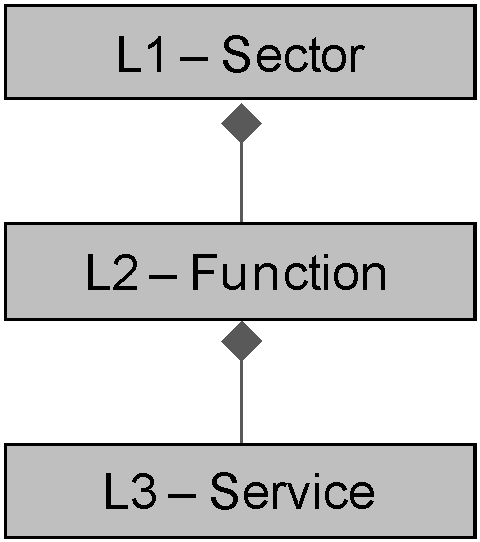
Figure 1: Structure of the Government Reference Model
Explanations of key terms:
- Sectors are identified as the business areas of the government
- Functions define what the government does at an aggregated level
- Services further define what the government does at a component level
- Drivers for Change are meta-factors – drivers are identified as shapers of the future; e.g., demographic changes or technological innovation
1.4 The TOGAF Standard and the Government Reference Model
The intent of the GRM is that this will sit in Phase B: Business Architecture of the TOGAF Architecture Development Method (ADM) cycle. This will provide a reference for individuals in the public sector and a pattern for accelerating the development of a reference model within the Business Architecture space.
International Affairs and Trade consists of activities undertaken by the government to facilitate financial support and trade with international economies and related to the conduct and implementation of policies, aid programs, treaties, and diplomatic relations.
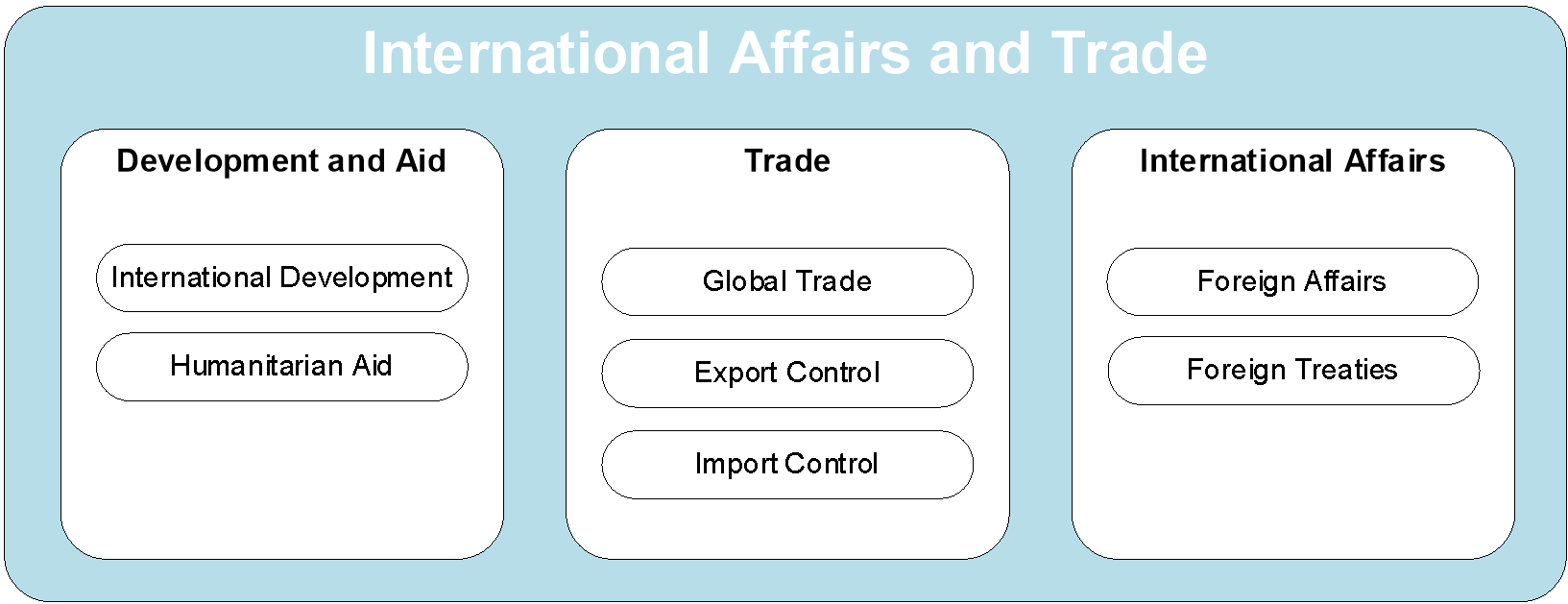
Figure 2: Structure and Content Overview of the L1-L3 Elements of the Proposed International Affairs and Trade Sector
2.1 International Affairs and Trade Taxonomy
|
Sector |
Function |
Service |
Description |
|
International Affairs and Trade |
Development and Aid |
Services that aid development and provide humanitarian assistance to less developed economies. |
|
|
International Development |
Comprises activities that aid development to developing economies through voluntary transfer of goods and services. |
||
|
Humanitarian Aid |
Refers to activities that support less developed economies in order to facilitate growth and recovery from conflict. |
||
|
Trade |
Services to increase prosperity through enabling overseas trade. |
||
|
Global Trade |
Pertains to activities undertaken to increase economic wealth by enabling trade overseas and facilitating the movement of goods and services. |
||
|
Export Control |
Regulates the international sale and movement of goods from the country and ensures compliance with domestic and international protocols and guidelines. |
||
|
Import Control |
Regulates the international purchase and movement of goods into the country and ensures compliance with domestic and international protocols and guidelines. |
||
|
International Affairs |
Services that maintain international relationships by providing overseas diplomatic advice and negotiating partnerships and agreements. |
||
|
Foreign Affairs |
Refers to international contributions by providing diplomatic assistance and conducting consultations with international governments. |
||
|
Foreign Treaties |
Activities that maintain relationships with international governments by monitoring existing treaties and negotiating partnerships and formal agreements. |
||
2.2 Key Drivers for Change
The future of international affairs and trade will be impacted by the trends captured below.
Powerful Political Forces Setting Agenda
Current demographics have led to a tacit assumption among rich and economically powerful nations that a mix of representative government, free market economies, and reformed state structures should represent future norms. However, the increased role of governance has led to growing tendencies to impose normative and administrative frameworks on aid organizations in order to regulate, register, and control their activities.
New Types of Vulnerabilities
Supply-side shocks have caused reductions in the prices of primary goods. The COVID-19 pandemic has contributed to contractions in investment and international trade as markets shut down businesses temporarily and restrict travel and the movement of people, leading to contractions in household spending and output levels.
This has revealed the fragility of global supply chains and, when combined with diplomatic tensions, could motivate multinationals to explore near-shoring more seriously.
De-Globalization
Trends in populism and nationalism have ensued from leading economies, undermining global organizations by promoting protectionist practices through the creation of barriers in technology. Moreover, East Asian economies are becoming more self-reliant and less dependent on the Western world. These factors will play a part in the fragmentation of global supply chains whereby newly industrialized countries will start to take a regional approach to trade and investment flows.
Technology
Investment in digital trade will enable organizations to maximize business value from information, improve decision-making, and drive efficiencies. The following technologies are expected to be leveraged in the coming years:
- Blockchain technology: this will be used to increase accountability, transparency, and potentially remove corruption
This technology will be used to distribute and trace aid funding, provide and manage IDs in refugee camps, or create trustworthy land registries enabling decentralized ledgers by recording transactions across a peer-to-peer network.
- Digital Identity: in the future, it is likely that citizens will be required to use their biometric identification through, for example, retina scans, fingerprints, or facial recognition to open a bank account, register to vote, and obtain permits and licenses
- Data Analytics: dashboards created through the consolidation of databases will help identify safe delivery paths for aid in conflict zones and help find better locations to store warehouse goods
- Collaboration Tools: treaty creation/treaty management solution and refinement and dispute resolution will be enabled by collaborative software and tools (e.g., document sharing, instant messaging, cloud storage, videoconferencing, analytics, cross-reference searching)
Defense and Security corresponds to the research, maintenance, equipment, procurement, operations, and development of forces, weapons, and related entities. This also comprises remuneration and benefits paid to all active and non-active civilians and personnel.
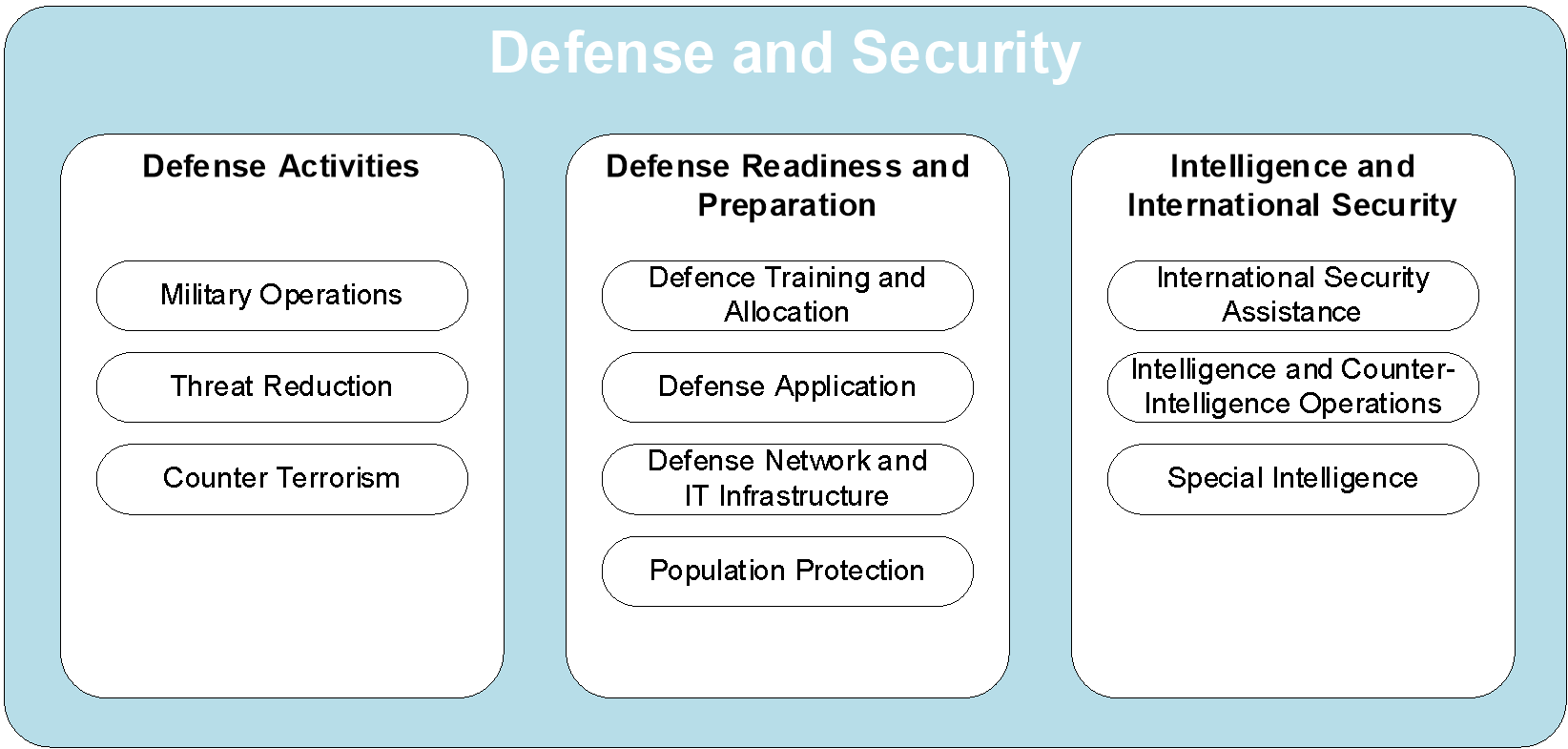
Figure 3: Structure and Content Overview of the L1-L3 Elements of the Proposed Defense and Security Sector
3.1 Defense and Security Taxonomy
|
Sector |
Function |
Service |
Description |
|
Defense and Security |
Defense Activities |
Programs leveraged by national defense that include defense-related activities, threat reduction, and counter-terrorism. |
|
|
Military Operations |
Corresponds to all miscellaneous defense-related events (e.g., expenses related to procurement external to national defense). |
||
|
Threat Reduction |
Corresponds to the activities to reduce and prevent the spread of goods or confidential data related to threats. This will include data exploitation, effective information maneuver, and cybersecurity operations. |
||
|
Counter-Terrorism |
Includes domestic and international responses that correspond to the elimination and deterrence of acts of terrorism. |
||
|
Defense Readiness and Preparation |
Maintenance, equipment, procurement, and development of forces, infrastructure, remuneration, and benefits paid to personnel. |
||
|
Defense Training and Allocation |
Corresponds to the improvement of individuals and collective performance within defense through real-life tasks and functions and simulated training environments to integrate the use of maneuver and engagement activities. |
||
|
Defense Application |
Includes activities used to achieve defense objectives in all environments through amalgamation of the use of engagement and maneuver. |
||
|
Defense Network and IT Infrastructure |
Corresponds to the movement of information in order to satisfy the connectivity and interoperability needs of the defense. |
||
|
Population Protection |
Includes all activities that ensure the security of and protect the general population, government, and leaders. |
||
|
Intelligence and International Security |
Activities to protect, analyze, and comprehend the needs and interests of the government and allies. |
||
|
International Security Assistance |
Corresponds to all activities used to protect the government’s interests and respond to potential threats by exploiting cross-governmental IT infrastructure, networks, and information. |
||
|
Intelligence and Counter-Intelligence Operations |
Includes all activities that encompass the ability to analyze and comprehend the needs of the government and citizens. |
||
|
Special Intelligence |
Pertains to advanced services that process, analyze, and collect information in order to support national interests. |
||
3.2 Key Drivers for Change
Technology and transformation are common themes throughout the defense sector. These have been driven by major forces such as rogue states, cyber attacks, terrorism, and competition between nations for technological superiority. To mitigate skills shortages and broaden the talent pool, there is an obligation for defense organizations to establish active monitoring, retention, recruitment, and training practices.
A summarized description of the trends is provided below.
Infrastructure Optimization
It is necessary for armed forces to develop military infrastructure that offsets scrutiny of spending, is environmentally sustainable, and fit for the evolving nature of conflict to achieve strategic objectives. Aging equipment and maintenance thereof is a major challenge. Opportunities to modernize infrastructure can be achieved by:
- Making defense infrastructure more environmentally sustainable by developing a vision that reflects the needs of tomorrow’s forces
- Leveraging finance from the private sector to build and maintain defense infrastructure
- Identifying the potential for automation of infrastructure management to free up personnel for mission-critical tasks
Workforce Transformation
Defense establishments are facing tough competition from the private sector in recruiting and retaining specialist personnel to operate increasingly sophisticated equipment. This has led to skill shortages in niche areas of engineering, cyber, and nuclear, hindering their ability to respond to technological advances. Broadening the pool of talent by encouraging greater diversity (in both leadership and combat roles) and increasing cyber recruitment will help meet evolving military needs.
Technology
Technological change has been the driving force that defines future defense challenges, creating new opportunities and efficiency that enable countries to gain technological dominance over other nations. Cybersecurity, Big Data, Artificial Intelligence (AI), robotics, and autonomous vehicles are already causing drastic shifts in global security. These will be supplemented by directed energy weapons, hypersonic platforms, and reusable swarm technologies over the coming years. New technologies will make logistics more complex and challenge the way defense leaders manage their organizations.
Contemporary Operating Environment
The nature of competition in the international arena has changed and old paradigms have become obsolete, making traditional dichotomies such as opponents/allies or training/operations more nuanced and mutable. Defense establishments must also be able to train and operate against so-called “sub-threshold conflict” where actions of an adversary fall short of the traditional criteria for military action, and in a context where competitors may also be allies in a geographic, temporal, or domain context. This dynamic and multi-domain environment requires defense establishments to be more agile and responsive to change, and seek new routes to exploit opportunities and advantages in order to maintain a competitive edge.
General Government and Local Services involves the provision of general customer services and operations including registrations, licensing, applications, workforce planning, social services, management of labor rights, and local services.
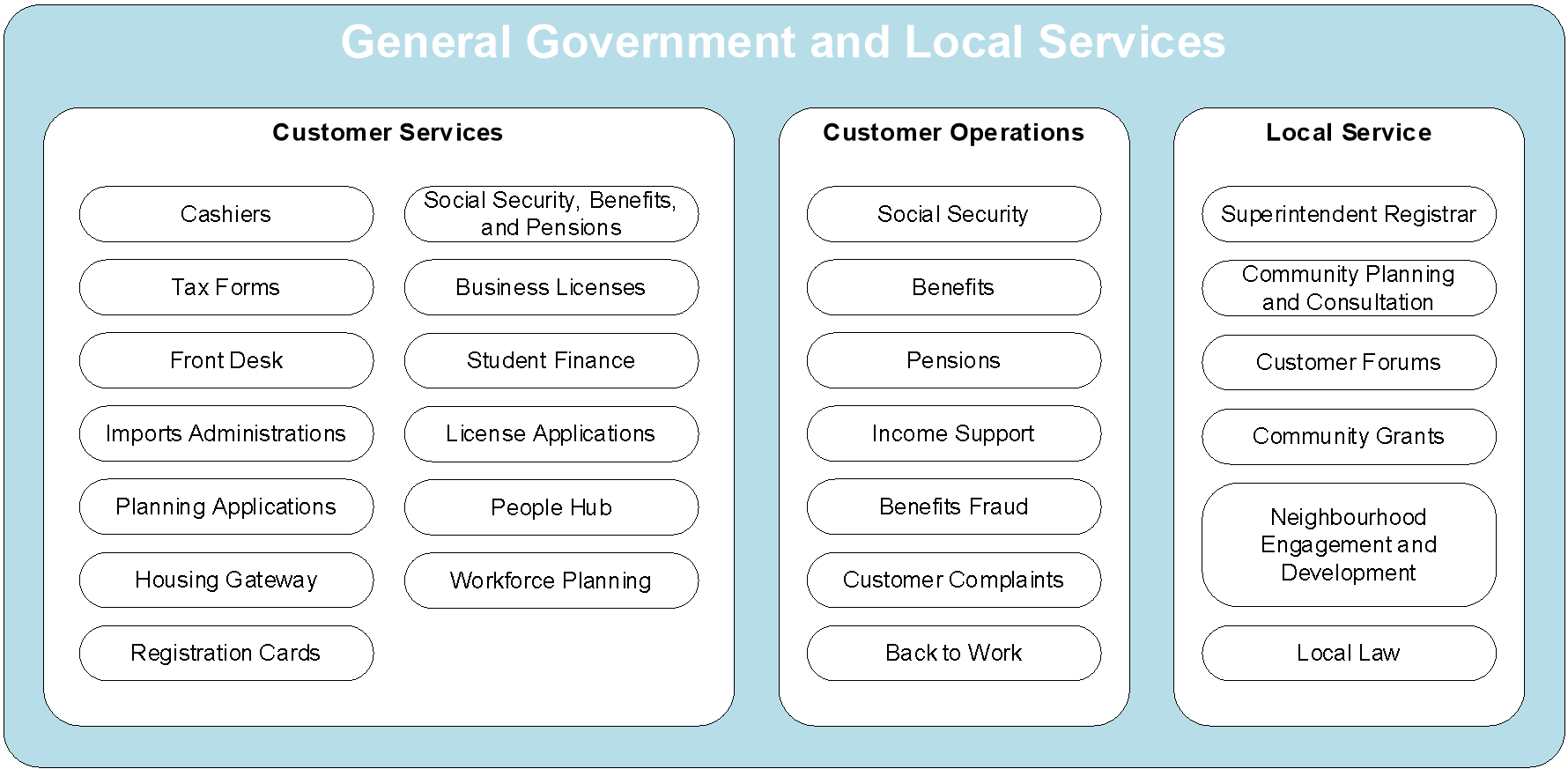
Figure 4: Structure and Content Overview of the L1-L3 Elements of the Proposed General Government and Local Services Sector
4.1 General Government and Local Services Taxonomy
|
Sector |
Function |
Service |
Description |
|
General Government and Local Services |
Customer Services |
Provides assistance and advice to the users of the services. |
|
|
Cashiers |
Refers to the provision of individuals who are responsible for dealing with incoming enquiries and oversee general clerical duties. |
||
|
Tax Forms |
Involves the support and provision of forms to taxpayers and tax-exempt organizations to report financial information. |
||
|
Front Desk |
Encompasses the operation and co-ordination of individuals responsible for performing administrative duties. |
||
|
Imports Administrations |
Responsible for collection, preparation, and general enquiries regarding import documents for entry of shipments from abroad. |
||
|
Planning Applications |
Refers to the overall management and paperwork of planning permissions in order to gain consent to build on land, or change the use of land. |
||
|
Housing Gateway |
Refers to the operation, eligibility, and application assessment of affordable housing purchase schemes. |
||
|
Registration Cards |
Activities associated with the overall management and paperwork for individuals claiming asylum. |
||
|
Social Security, Benefits, and Pensions |
Refers to activities associated with queries, paperwork required in order to apply for a social security number, benefits and pension schemes, and potential discrepancies that may arise. |
||
|
Business Licenses |
The process associated with completing an application to initiate a business. |
||
|
Student Finance |
Encompasses the management and provision of student loans and grants to cover tuition fees and costs associated with undertaking higher education. |
||
|
License Applications |
Activities associated with the overall management and paperwork of the documented authority necessary to perform a regulated role. |
||
|
People Hub |
Oversees the hiring, administration, and training of staff within customer services and operations roles. |
||
|
Workforce Planning |
Encompasses the analysis of the current and future workforce in order to identify gaps and enable the general government and local government to achieve strategic goals. |
||
|
Customer Operations |
The functions that directly engage the public. |
||
|
Social Security Administration |
Undertakes the responsibility for the assignment of social security numbers and administers social security retirement, survivors, and disability insurance programs. |
||
|
Benefits |
Addresses provision and determination of eligibility for benefits including income-related benefits, housing benefits, child benefits, carer benefits, and disability benefits. |
||
|
Pensions |
Encompasses the distribution of fixed payments periodically to support citizens’ retirement from work. |
||
|
Income Support |
Involves the provision of extra money to individuals on low incomes. |
||
|
Benefits Fraud |
Encompasses the conduct and investigation of individuals claiming benefits to which they are not entitled. |
||
|
Customer Complaints |
Includes the ability to assess and address individuals’ dissatisfaction with customer operations. |
||
|
Back to Work |
Provides guidance, support, and information for individuals looking to return to work following a career break. |
||
|
Local Service |
Provides services within a specific location or community. |
||
|
Superintendent Registrar |
Oversees the registration of births, marriages, and deaths in the local community. |
||
|
Community Planning and Consultation |
Refers to the provision of information and recommendations to local community groups on budget and legal issues, and general advice on local projects and services. |
||
|
Customer Forums |
The provision of an online avenue used to integrate a community and share feedback. |
||
|
Community Grants |
The provision of grants and loans to community groups in order to fund local projects and services. |
||
|
Neighborhood Engagement and Development |
Supports the establishment of local networks and activities, liaises with businesses to support community projects, and organizes activities for residents. |
||
|
Local Law |
Provides advice and applies legal processes at town and area level. |
||
4.2 Key Drivers for Change
Several factors are driving fundamental change in the General Government and Local Services sector whereby the government will need to consider the points below.
Manage Changing Expectations and Reputation
This will be used to improve quality of service by procuring specialist personnel performing value-added activities, using knowledge-based infrastructure to enable accurate transaction processing, and tailoring services based on market segmentations.
Other approaches undertaken to manage expectations include:
- Personalized Customer Experience by using data in CRM software to evaluate user history: creation of a personalized digital profile by using a centralized data hub will enable services to meet individual expectations and improve response times
- Operational Innovation: provide service and support outside the traditional channels 24/7, create data and knowledge-sharing infrastructure, learn from customer data, and realign compensation with customer satisfaction and retention
- Utilizing Skilled Associates to Manage Needs: implement/acquire a standards-defined, intensive multi-disciplinary training curriculum that includes:
— Formal taxpayer relations
— Service offerings
— Technology
— Proactive selling
— Taxpayer contact etiquette
— Cross-functional team skills to ensure the ability to backfill and provide appropriate coverage
— Performance shortfalls addressed with counseling and investment in further training
Environment
At a national and local level, governments should address the pressing crisis of climate change. Improvement of air quality, managing waste and recycling, promoting low transport emissions, and building green infrastructures are some of the actions towards mitigating climate change. These should also lead to cultural changes supporting both a better quality of life and climate resilience. Research and innovation are also important and will assist with these goals.
Young People and Education comprises educational programs that correspond to early years, primary school, secondary school, higher education, and specialist schooling. This also includes children’s social services, safeguarding, and associated children and adolescent services; as well as skill or training activities undertaken by the government to promote education.
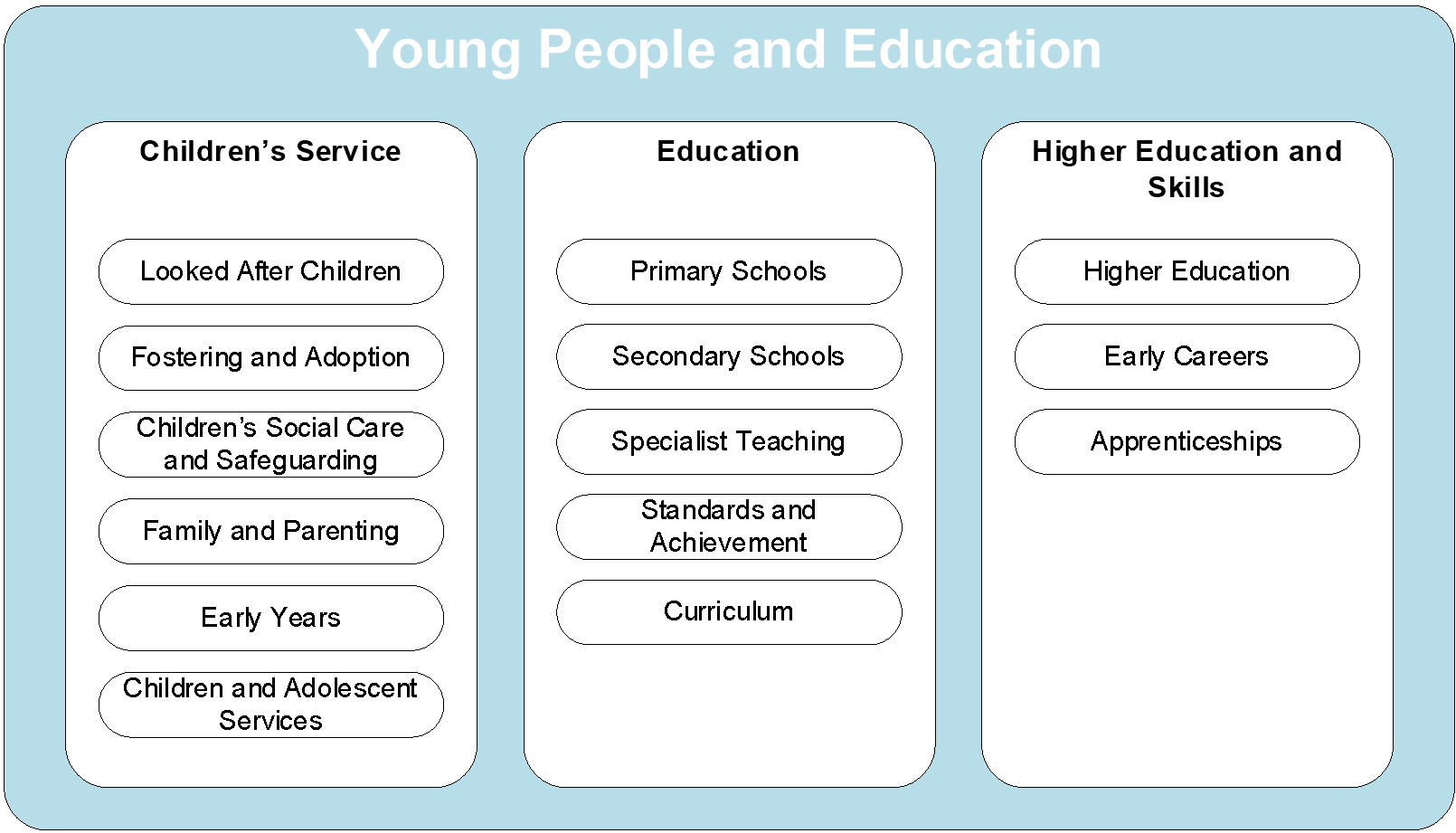
Figure 5: Structure and Content Overview of the L1-L3 Elements of the Proposed Young People and Education Sector
5.1 Young People and Education Taxonomy
|
Sector |
Function |
Service |
Description |
|
Young People and Education |
Children’s Service |
Corresponds to social services, and additional safeguarding, adolescent support, and parental support in early years. |
|
|
Looked-after Children |
Individuals in the care of local authorities as a result of mandatory care orders or parent agreements. |
||
|
Fostering and Adoption |
The provision of temporary or long-term responsibility of a child to a surrogate parent. |
||
|
Children’s Social Care and Safeguarding |
Comprises safeguarding training, policies, and processes to ensure all children are protected from harm. |
||
|
Family and Parenting |
Includes activities to offer information and support to parents and carers to promote emotional wellbeing and positive family relationships. |
||
|
Early Years |
Provides activities that support the learning, development, and care of children prior to entering schooling. |
||
|
Children and Adolescent Services |
Provides support and guidance through a number of transition stages to adulthood. |
||
|
Education |
Includes the provisioning of skills and knowledge to children through schooling, education, and adherence to national expectations and standards. |
||
|
Primary Schools |
Consists of activities that provide education at an elementary level, with focus on reading and writing. |
||
|
Secondary Schools |
The provision of education through secondary-level educational establishments. |
||
|
Specialist Teaching |
Provides extra help, adapted programs or learning environments, specific equipment, or materials to support students. |
||
|
Standards and Achievement |
Comprises developing course materials, learning materials, resources, exam material, and exam administration that adhere to education standards and accredit education qualifications. |
||
|
Curriculum |
Outlines mandatory courses and units to be completed and communicates with departments to ensure consistency across education establishments. |
||
|
Higher Education and Skills |
Supports the provision of further education and training for work-related disciplines including apprenticeships, on-the-job training, and communications with industry and tertiary institutions. |
||
|
Higher Education |
Comprises education beyond secondary schooling. |
||
|
Early Careers |
Includes the provision of training through workplace and traineeships. |
||
|
Apprenticeships |
Consists of on-the-job training amalgamated with classroom training. |
||
5.2 Key Drivers for Change
Education institutions must embrace new technologies to enable personalized learning and develop supportive international education policies that are integrated with broader national strategies.
In order to do so, they should consider the policies described below.
Innovate Curriculums and Engage with Students at an Individual Level
Education providers should use new digital tools such as AI, Virtual Reality (VR), Internet of Things (IoT), advanced analytics, and cognitive systems to create personalized learning paths. This will facilitate the collection of information on personal goals, learning profiles, performance, and co-curricular activities of each student. Key features provided from this will include utilization of predictive analytics and competency-based learning to enable customized learning and provide a detailed view of individual student capabilities.
Internationalize Education
The world is moving towards “education without borders” owing to global competition for talent, academic mobility, overseas internships, and emergence of international campuses. Developing strategies and simplifying migration policies to internationalize education will promote national prosperity, reshape international relationships, and improve institutional and national visibility. This will subsequently enable emerging economies to become global competitors in the international student market.
Modernize Classrooms
The design of innovative campus structures by embracing new technologies can be used to address climate sustainability challenges. Examples of this may include:
- A shift towards innovation centers furnished with modern technologies (AI, 3D printing, and simulation environment) connected with industry players to facilitate live projects and prototyping
- Development of vertical schools that closely resemble the high-tech workplace to enable resource sharing with the community
Adjust National Curriculums
Education will be transformed to help people adapt to changing job market needs and learn repeatedly over the course of their lives to remain relevant in a world of disruption. To adapt to the changes of the job market, national curriculums will also need to be transformed to help students develop core skills of the 21st century, such as complex problem solving, critical thinking, collaboration, and digital literacy.
Health and Community Wellbeing encompasses medical and nursing governance, strategy and care services provided to individuals and families, research and the provision of hospital and community services to safeguard mental and physical health.
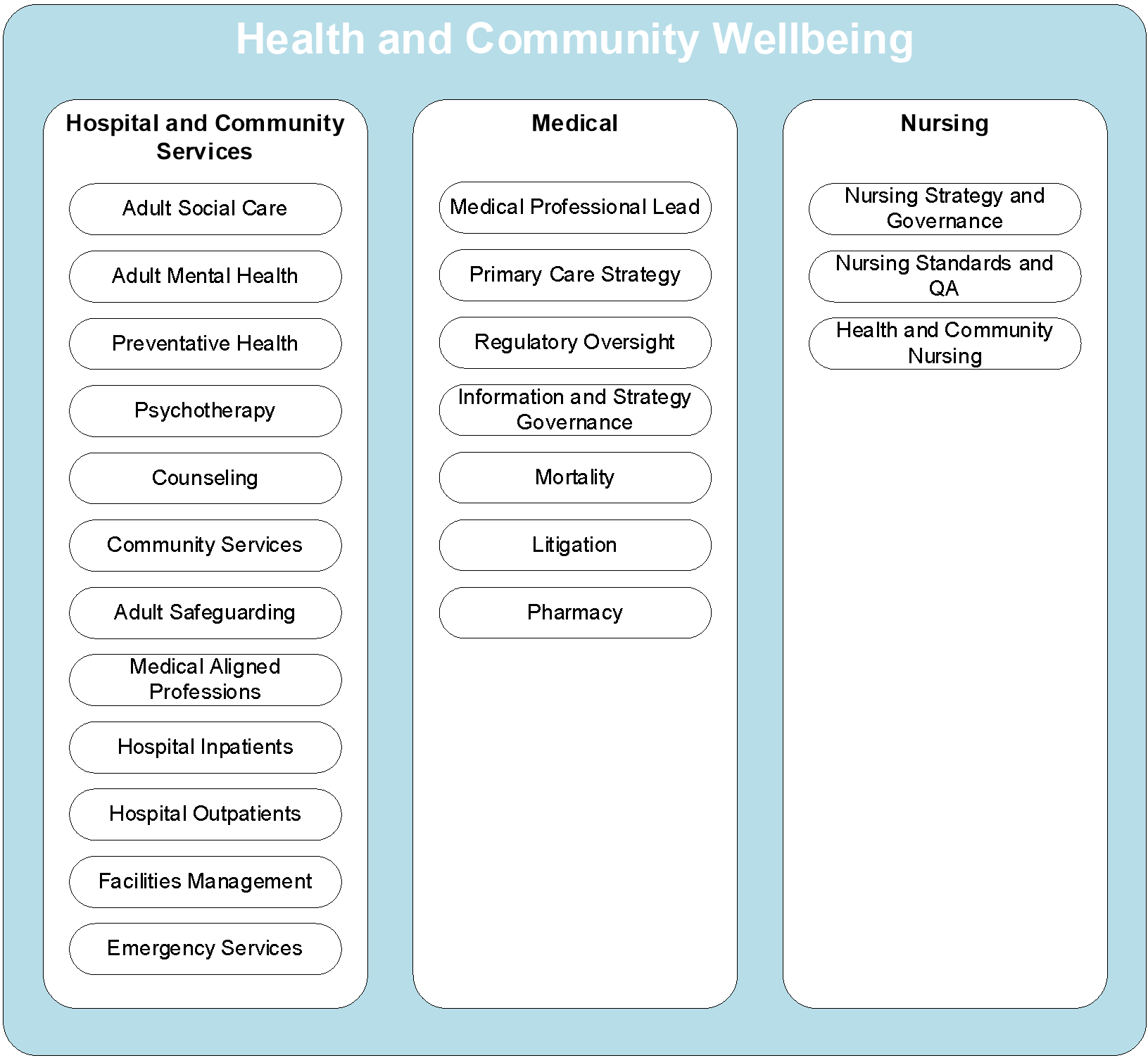
Figure 6: Structure and Content Overview of the L1-L3 Elements of the Proposed Health and Community Wellbeing Sector
6.1 Health and Community Wellbeing Taxonomy
|
Sector |
Function |
Service |
Description |
|
Health and Community Wellbeing |
Hospital and Community Services |
The provision of services in order to safeguard the mental and physical health of adults. |
|
|
Adult Social Care |
Involves activities required in order to support adults with physical or learning difficulties. |
||
|
Adult Mental Health |
Provides access to psychological, employment support, trauma informed care, medicines management, and personalized support for adults with mental health needs. |
||
|
Preventative Health |
Refers to care provisioned in order to prevent illnesses or diseases. |
||
|
Psychotherapy |
Involves the use of physiological methods to support and assist adults with mental and emotional difficulties. |
||
|
Counseling |
Involves the use of talk therapy in order to support and assist adults with mental and emotional difficulties. |
||
|
Community Services |
Involves protection of the physical and mental wellbeing of community members and monitoring community health services. |
||
|
Adult Safeguarding |
Comprises safeguarding training, policies, and processes to ensure all adults are protected from harm. |
||
|
Medical Aligned Professions |
Refers to the provision of diagnostic, technical, therapeutic, and support services by registered or qualified healthcare professionals. |
||
|
Hospital Outpatients |
The provision of hospital care and supervision for patients for less than one night. |
||
|
Hospital Inpatients |
The provision of hospital care and supervision for patients for at least one night. |
||
|
Facilities Management |
Corresponds to the maintenance, management, and upkeep of hospital and community facilities. |
||
|
Emergency Services |
The provision of pre-hospital care including ambulances, urgent response, and out of hospital treatment. |
||
|
Medical |
Includes type, classification, and/or specialization of healthcare. |
||
|
Medical Professional Lead |
Refers to the service that sets the direction for medical practices and healthcare professionals. |
||
|
Primary Care Strategy |
Provides the direction and framework for future primary care. |
||
|
Regulatory Oversight |
Refers to services used to co-ordinate functions that ensure policy is implemented consistently. |
||
|
Information and Strategy Governance |
Refers to the alignment of medical professionals, processes, tools, and technologies to achieve results. |
||
|
Mortality |
Refers to services and information related to a death and bereavement. |
||
|
Litigation |
Refers to any disagreements/legal action taken against medical parties in the public sector. |
||
|
Pharmacy |
Services that are conducted to prescribe, dispense, and distribute medication. |
||
|
Nursing |
The provision of services related to the care of the sick and infirm. |
||
|
Nursing Strategy and Governance |
Refers to the alignment of nursing services, processes, tools, and technologies to achieve results. |
||
|
Nursing Standards and QA |
Comprises activities used to evaluate standards of patient care and professional capabilities of nurses. |
||
|
Health and Community Nursing |
Manages care of the community, health, and leads teams of district nurses, community nurses, and support workers. |
||
6.2 Key Drivers for Change
The Health and Community Wellbeing sector faces enormous changes and challenges arising from greater life expectancy and as medical practices start to shift from traditional practices of prioritizing disease treatment to prevention.
As a result, governments will need to consider the points below.
Respond to Demographic Changes
It is reasonable to expect longer-term trends in life expectancy to continue as a result of a combination of:
- Improved diets
- More effective management of the use of pharmaceuticals
- Improved ability to manage complex diseases
- Better integration of health and social care
Consequently, we can expect the influence of ageing populations to increase pressure on the demand, and need, for public healthcare services.
Innovate
“Synthetic biology” is a multi-disciplinary scientific approach that uses an engineering approach to biology to design and build functions in cells. Annual investment in microbiome health and wellness start-ups has risen by 1,600% in the ten years up to 2020.
Innovation potential can be realized by using synthetic biology to engender personalized gene therapies to treat chronic disease and genetic disorders. Harnessing the capabilities of microorganisms will help solve existing health challenges and create opportunities across industries.
Incorporate Technology Advancements
The incorporation of technology advancements will result in fundamental changes to the use and ownership of data by using:
- AI and Intelligence: current technology leverages wireless and smart device technology to increase mobility of support – in the future, electronic health records will also be supplemented by patient collected data and genomics in order to enable codified real-time data
- Blockchain: blockchain technology will be used to archive related activity logs and as an additional layer of security to ensure the integrity of health records by recording and time stamping each instance of access or each change to a patient’s electronic records
- Sensors: precision sensors, including graphene and quantum sensors, can be used to conduct real-time monitoring of changes in the human body, collect data on performance of digital infrastructure, and have the potential to detect pathogens
- Quantum Computing: this will enable more efficient computing and facilitate drug discovery as progress accelerates
Judiciary, Justice, and Home Affairs covers the total cost of judiciary, prosecution, expenses connected with funding protection, law enforcement services, and the cost of criminal justice including incarceration, supervision, parole, and rehabilitation of prisoners.
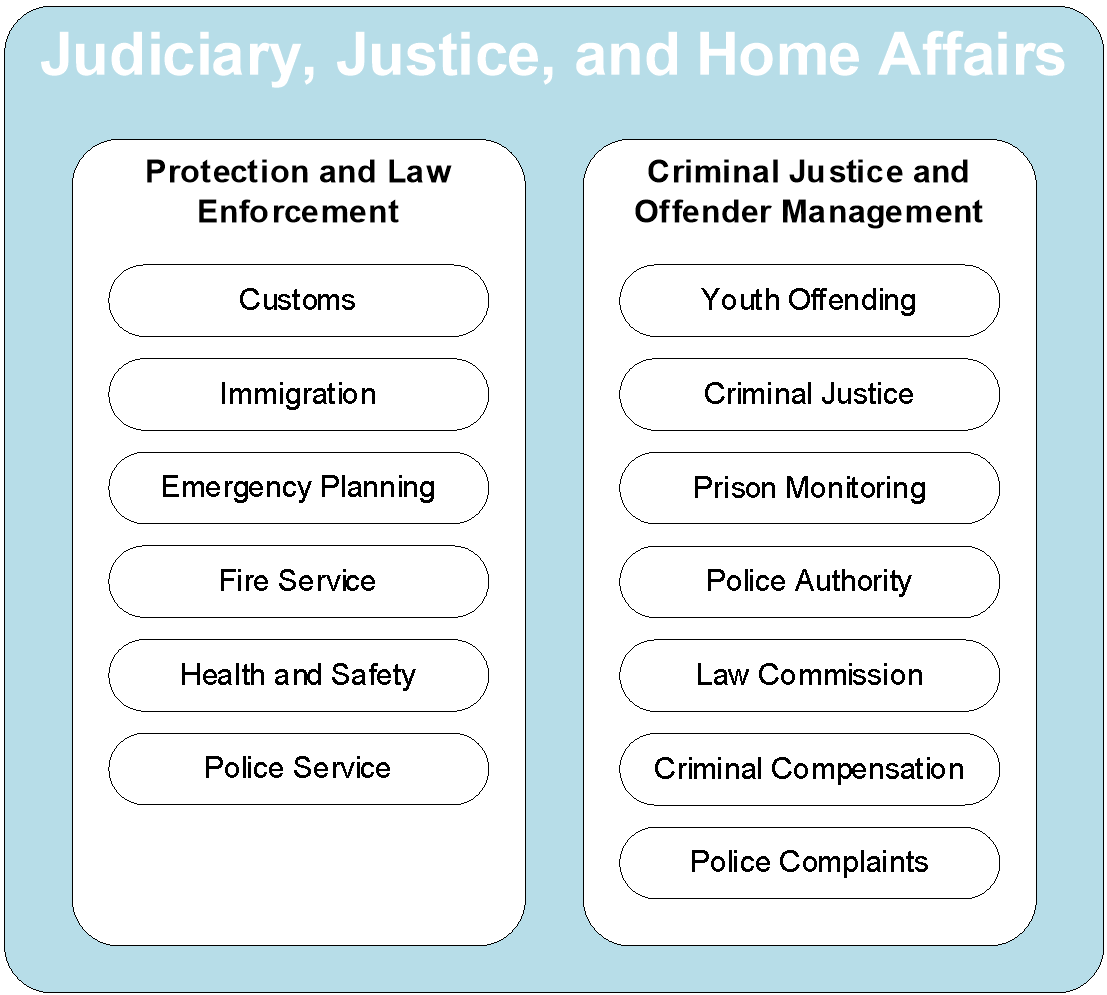
Figure 7: Structure and Content Overview of the L1-L3 Elements of the Proposed Judiciary, Justice, and Home Affairs Sector
7.1 Judiciary, Justice, and Home Affairs Taxonomy
|
Sector |
Function |
Service |
Description |
|
Judiciary, Justice, and Home Affairs |
Protection and Law Enforcement |
Refers to services that protect and safeguard the public and ensure compulsory compliance regarding the law. |
|
|
Customs |
Used to check for illegal goods or goods for which a tax may be applicable, and advises on quotas and customs regulations including inspections, cargo clearance, screen, and search. |
||
|
Immigration |
Monitors the status of incoming travelers from overseas to the country to confirm that they are permitted to enter, and ensures on-arrival clearance through the passenger entry control system. |
||
|
Emergency Planning |
Provides urgent assistance in unforeseen circumstances including emergency funding, logistical support, advises on equipment regulations, and co-ordinates government and community-based services. |
||
|
Fire Service |
Enables the provision of fire fighters and assistance to extinguish fires, minimize damage, promote fire safety, and enable emergency prevention, protection, and response. |
||
|
Health and Safety |
Consists of activities used to design, develop, and implement health and safety programs. |
||
|
Police Service |
Comprises activities that advise on rules and regulations, improve public safety, and reduce violence and use of illegal substances. |
||
|
Criminal Justice and Offender Management |
Refers to the delivery of justice to those that have committed crimes or offences. |
||
|
Youth Offending |
Oversees young offenders and provisions community services to prevent young people recommitting crimes in the future. |
||
|
Criminal Justice |
Encompasses the delivery of justice to individuals who have committed crimes and includes the provision of prosecution lawyers. |
||
|
Prison Monitoring |
Represents the monitoring of facilities used to detain criminal offenders. |
||
|
Police Authority |
Consists of activities that co-ordinate law enforcement services. |
||
|
Law Commission |
Reviews existing laws and recommends potential for reform if necessary. |
||
|
Criminal Compensation |
Encompasses programs that reimburse victims of crime for expenses related to the crime. |
||
|
Police Complaints |
Handles the assessment of dissatisfaction with a police force or individual to maintain public confidence. |
||
7.2 Key Drivers for Change
With advancements in technology, there is significant potential to improve and adapt the judiciary and justice sector as the political climate and regulations evolve with society. To advance the performance and efficiency of the judicial system, governments will need to consider the points below.
Prepare for New Threats
With social change comes new possible threats that will require reforms in the judiciary and justice sector but also greater prevention and training:
- With a more online focused population due to advances in technology and situations such as the COVID-19 pandemic, greater remote working and schooling can lead to an increase in cybercrime
The threat for fraud, data theft, grooming, stalking, or harassment is amplified. Reforms in the law to deal with those types of crimes are necessary, but most importantly processes to prevent them should be implemented.
- Civil rights movements can also be drivers for change, where the justice system adapts to society as it evolves
- Threats like organized crime, terrorism, and human trafficking will require greater co-operation between cross-border jurisdictions and law enforcements
Victim Support
Supporting victims of crime and traumatic incident is essential within the judicial system. Providing free services such as emotional support, counseling, safe places to stay, access to specialists, and financial support are crucial to help people move forward. To ensure their needs are met in the criminal justice system, victims should also be made aware of their rights, including being kept informed about the investigation and having their privacy respected.
Modernize Prison Infrastructure
Most criminal justice systems are increasingly reliant on prisons, with most failing to reach their objectives of keeping society safe. Countries with high reoffending rates tend to prioritize punishment within their prisons, whereas lower rates are seen in prisons that prioritize relationships and decency. The price of reforming is the principal reason for ageing prison infrastructure; however, inmate rehabilitation and successful reintegration are indispensable to ensuring public safety. More successful models, such as the Scandinavian model is generally considered to be, can guide a template to justify this investment.
Leverage New Technologies
The use of technology to modernize the judiciary and justice system has multiple purposes:
- Better access to the law online increases the amount of information or services available to court users such as online settlement forms, user-friendly information portals to learn about their rights, and procedural steps
The use of digital communication and information tools can create a more accessible public justice service to more citizens.
- Re-designing processes by improving the communication and co-operation between professionals, the quality of decisions based on larger legal databases, and reducing the administrative burden
This can simplify and accelerate procedures, make them more user-centric, and reduce time and costs.
- Facilitate cross-border co-operation to overcome barriers of distance and language and complexities in accessing justice in other countries
The Europa portal or e-CODEX[1] provides online tools such as guidelines, forms, information for legal practitioners, authorities, and citizens to exchange more easily and speed up processes.
- Improve the criminal justice process through new technologies like IoT, AI, and sensors to assist in solving investigations but also in preventing crimes
Shared databases have also proven to be essential to law enforcement; for example, in linking suspects to crimes or improving evidence analysis and processing.
The Financial sector maintains controls over public spending, revenue, financial reporting, auditing, and providing the direction for future investment decisions and financial planning.
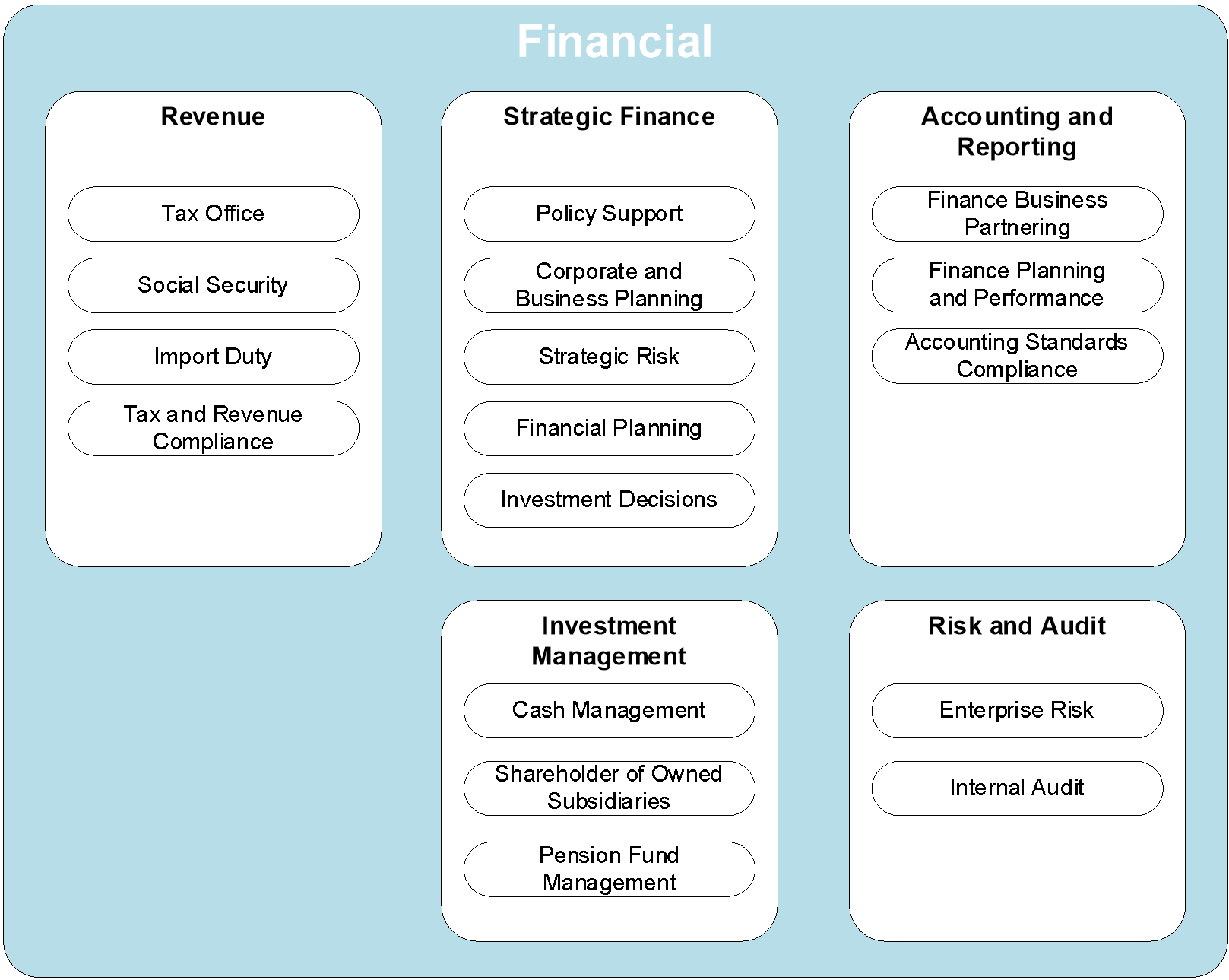
Figure 8: Structure and Content Overview of the L1-L3 Elements of the Proposed Financial Sector
8.1 Financial Taxonomy
|
Sector |
Function |
Service |
Description |
|
Financial |
Revenue |
Activities associated with the collection of money owed to the government from domestic and foreign sources. |
|
|
Tax Office |
Responsible for the administration of the tax system, tax policy development, maintenance, and implementation. |
||
|
Social Security |
Promotes the welfare of the population through assistance measures to help in case of instability of living and to prevent such instability. |
||
|
Import Duty |
The collection of taxes on imports and some exports by customs authorities. |
||
|
Tax and Revenue Compliance |
Supports individuals and businesses towards compliance with taxation requirements and surrendering of taxes and levies to the government. |
||
|
Strategic Finance |
Activities pertaining to delivering long-term financial strategies to support future service delivery, financial monitoring, and control. |
||
|
Policy Support |
Assesses the sustainability of current programs and policies. |
||
|
Corporate and Business Planning |
Examines internal capabilities and lays out strategies for how to use those capabilities to meet goals. |
||
|
Strategic Risk |
Analyzes exposure to risk and determines appropriate measures to ensure continued activities. |
||
|
Financial Planning |
Assesses the long-term fiscal needs of the government and acquires, allocates resources, and manages costs. |
||
|
Investment Decisions |
Determines where and how much capital will be spent on investment opportunities. |
||
|
Accounting and Reporting |
Activities to identify, organize, classify, record, summarize, and communicate information of financial transactions. |
||
|
Finance Business Partnering |
Manages business partnerships and relationships between businesses, organizations, and individuals that contribute to the government’s objectives. |
||
|
Finance Planning and Performance |
Defines the set of capabilities to measure the effectiveness of a government’s financial assets and capital. |
||
|
Accounting Standards Compliance |
Ensures that accounting information is uniform and accounting decisions are made in a reasonable way. |
||
|
Investment Management |
Refers to the handling of financial assets and other investments. |
||
|
Cash Management |
The process of collecting and managing cash flows. |
||
|
Investments |
Monetary assets acquired with the goal of generating income in the future. |
||
|
Shareholders of Owned Subsidiaries |
Refers to shares in a company owned or controlled by a parent company. |
||
|
Pension Fund Management |
About investing and managing pension fund assets to optimize contributions made into that pension fund. |
||
|
Risk and Audit |
Methodical examination and review of regulated activities to ensure compliance with standards for regulated activity. |
||
|
Enterprise Risk |
Identifies and addresses the potential events that represent risks to the achievement of strategic objectives. |
||
|
Financial Governance |
Collects, manages, monitors, and controls financial information. |
||
|
Internal Audit |
Provides independent assurance that a government’s risk management, governance, and internal control processes are operating effectively. |
||
8.2 Key Drivers for Change
In recent years, the pace of technological change, evolving customer expectations, and a changing regulatory framework have led to continued innovation in the Financial sector such as fintech, mobile banking, and crypto currencies. Combined with recent market disruptions, such as the COVID-19 global pandemic, the long-term impacts remain unclear. To adapt and build resilience, the Financial sector needs to transform accordingly.
A summarized description of the drivers for transformation is provided below.
Strategic Shock
Unprecedented market disruptions like the COVID-19 pandemic have led to important changes in public spending. This has resulted in increased expenditure, reduced revenue, and greater levels of market volatility.
- To maintain financial stability in a crisis, policy responses must be coordinated with regulators and central banks to minimize impact
Monetary and fiscal policies should be coordinated to safely meet the public’s needs, adapted to the situation, and implemented strategically depending on national priorities.
- Crisis recovery necessitates rethinking of approaches to public finances
Leveraging technology to better predict a future crisis and its impact; introducing resilience-building criteria for the allocation of public investments; and integrating social and environmental objectives into recovery plans are some of the measures that can be taken when reshaping the finance function.
Fast Technological Change
As in the private sector, technological innovations are driving change in the public finance function. With greater public scrutiny and tech fluency, governments are also pressured to innovate using technologies.
- Big Data and predictive analytics can help make better financial decisions with public finances, identify and minimize risks, thus improving financial planning and performance
- Back-office transformation is driven by AI, robotics, and automation that can reduce manual work and remove the administrative burden from employees so that efforts can shift towards more productive roles
- With a greater use of technologies, there are more entry points for potential attacks; cybersecurity should be at the forefront and the government will need to be more responsible with data collected from the public and ensure data security policies are implemented
- Other technologies such as affective computing or “emotional AI” can be used by governments to influence the behavior of citizens
Growth, Housing, and Environment corresponds to activities that ensure natural and urban environment responsibility, provision of core infrastructure, and protection of citizens’ standards of living and safety through the licensing and enforcement of regulation.
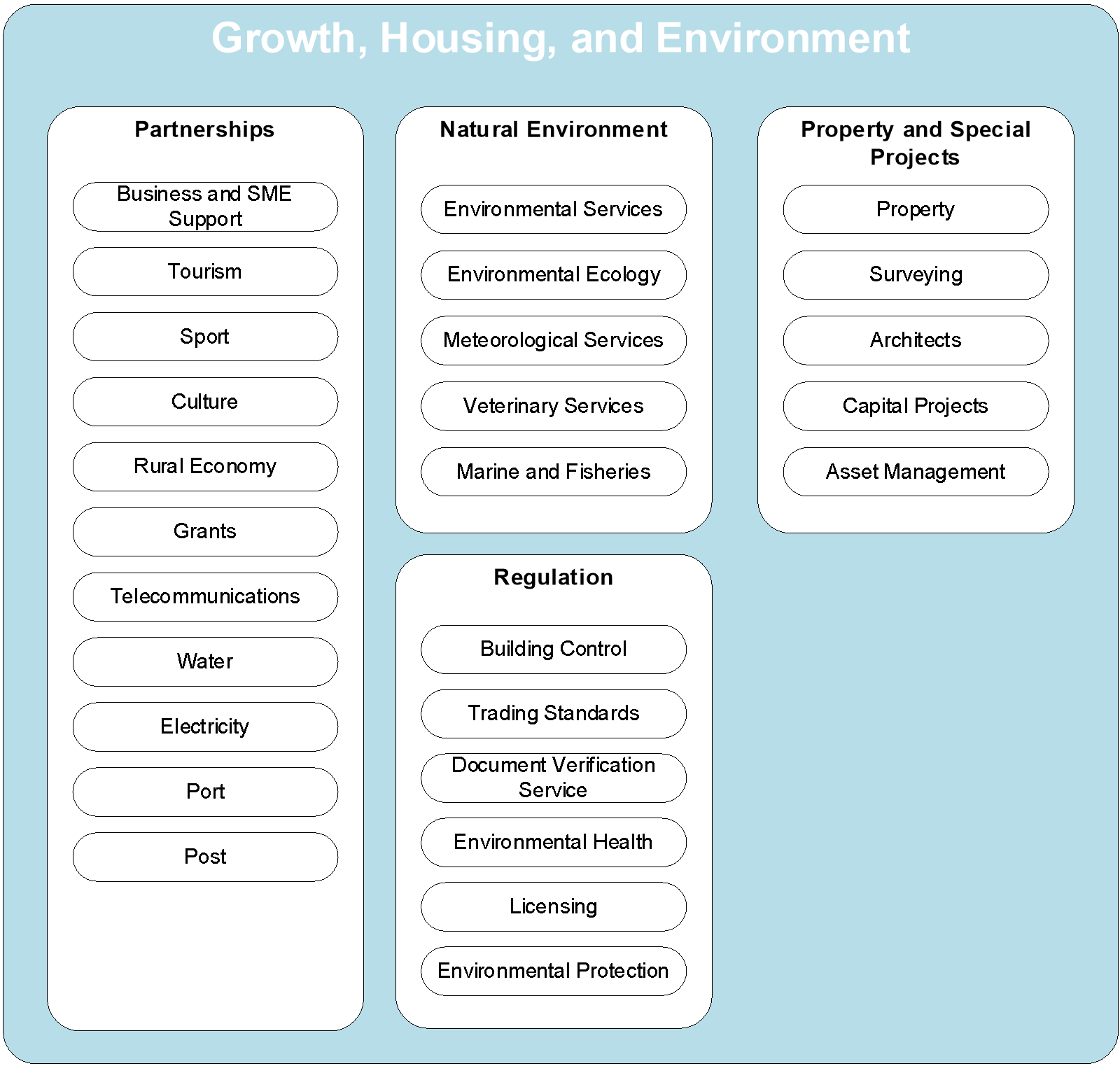
Figure 9: Structure and Content Overview of the L1-L3 Elements of the Proposed Growth, Housing, and Environment Sector
9.1 Growth, Housing, and Environment Taxonomy
|
Sector |
Function |
Service |
Description |
|
Growth, Housing and Environment |
Partnerships |
Relationships between two or more functions. |
|
|
Business and SME Support |
Provides support systems to small and medium-sized enterprises and businesses. |
||
|
Tourism |
Encourages recreational visitors to the area, supports the tourism industry, and advises on tourism regulations. |
||
|
Sport |
Encompasses activities required to maintain, run, and advise on regulations for recreational and sporting facilities. |
||
|
Culture |
Pertains to activities that support development and management of the arts and cultural organizations, such as museums, galleries, and artifacts. |
||
|
Rural Economy |
Encompasses activities associated with the development, investment, and regulation of nature, agricultural activities, and the human environment. |
||
|
Grants |
Refers to the provision of loans in order to assist with funding partners. |
||
|
Telecommunications |
Involves the support of telecommunications organizations that transmit signals and advises on regulations, standards, and new technology associated with telecoms. |
||
|
Water |
Refers to the activities that support water industry partnerships, and advises on regulations and standards associated with water management and usage. |
||
|
Electricity |
Refers to the activities that support industry partnerships, and advises on regulations and standards associated with electricity usage and power. |
||
|
Port |
Refers to the activities that support industry partnerships and adequate regulation of maritime ports. |
||
|
Post |
Refers to the activities that support the collection and delivery of packages and letters, issues postage stamps, and advises on regulations and standards associated with mail. |
||
|
Natural Environment |
The management and conservation of the surrounding environment and wildlife to protect and ensure sustainability of the natural environment. |
||
|
Environmental Services |
Refers to the maintenance, safeguarding, and provision of advice in order to preserve the natural environment. |
||
|
Environmental Ecology |
Refers to activities to modify a habitat to a better state, protect ecosystems, and support conservation. |
||
|
Meteorological Services |
Involves the provision of advice, information, and warnings about the climate, weather forecasts, and severe weather. |
||
|
Veterinary Services |
Refers to advice and research provided to ensure good health of domestic animals. |
||
|
Marine and Fisheries |
Carries out maintenance and promotes community awareness of sea-based areas of the natural environment. |
||
|
Property and Special Projects |
Delivers investment and management services for development and infrastructure projects. |
||
|
Property |
Pertains to activities that support, develop, and manage buildings. |
||
|
Surveying |
Refers to the valuation, costing, management, marketing, and maintenance of public property and buildings. |
||
|
Architects |
Encompasses the activities associated with the planning, design, and construction of properties and buildings. |
||
|
Capital Projects |
Refers to the support, development, and management of long-term investment projects. |
||
|
Asset Management |
Accounts for support for the management of government assets. |
||
|
Regulation |
Refers to the delivery of regulatory processes. |
||
|
Building Control |
Determines the minimum standards required for design and construction. |
||
|
Trading Standards |
Refers to the enforcement of legislation associated with partnerships to ensure protection of consumers. |
||
|
Document Verification Service |
Verifies key government issued documentation to ensure adherence to legislation and mitigate fraud. |
||
|
Environmental Health |
Advises and evaluates the effects of industry, tourism, or community use on the natural environment. |
||
|
Licensing |
Refers to activities associated with granting, revoking, and management of the documented authority required to perform a regulated task or function. |
||
|
Environmental Protection |
Refers to activities associated with the correcting and offsetting of environmental deficiencies. |
||
9.2 Key Drivers for Change
The Growth, Housing, and Environment sector faces important challenges as climate change becomes one of the greatest threats for the planet, accelerated by a growing population and increased consumption. The factors below will be considered as drivers.
Population Growth and Economic Activity
There is an increasing population with demographic changes, as well as social changes. Faster urbanization and more economic spending also lead to a strain on natural resources, increased wastage, and pollution, and thus accelerate climate change. All these factors should be taken into consideration when dealing with and mitigating the threat of climate change. In fact, younger generations are more progressive on social issues through greater availability of information, digitalization, and travel. It is important to work towards policies and regulations that create a more sustainable future for these generations.
Climate Change
Humanity is dependent on the environment for water, air, food, and shelter. With population growth, the use of polluting, carbon-intensive technologies and over-exploitation of resources has led to challenges for future generations. It is necessary for leaders to consider climate risks and impacts more seriously, including adverse effects on supply chains and physical infrastructure. Over the past couple of years, many governments have been in the process of implementing green recovery plans and funding projects that will alleviate decarbonization.
Digitalization and Technology
Advancements in technology have allowed a greater use and exploitation of renewable energies. But new technologies can also help to focus on mitigating the effects of climate change rather than recover from them. Digitalization of processes can significantly reduce costs but also operational waste, and this also applies to housing. The development of “smart cities” is an opportunity to decouple economic and population growth from environmental change.
Policy, Performance, Population, and Innovation involves the development of policy across the government, the provision of statistics for population and performance against benchmarks to ensure continuous improvement, and incorporates strategic and long-term planning to identify future risks, opportunities, and solutions.
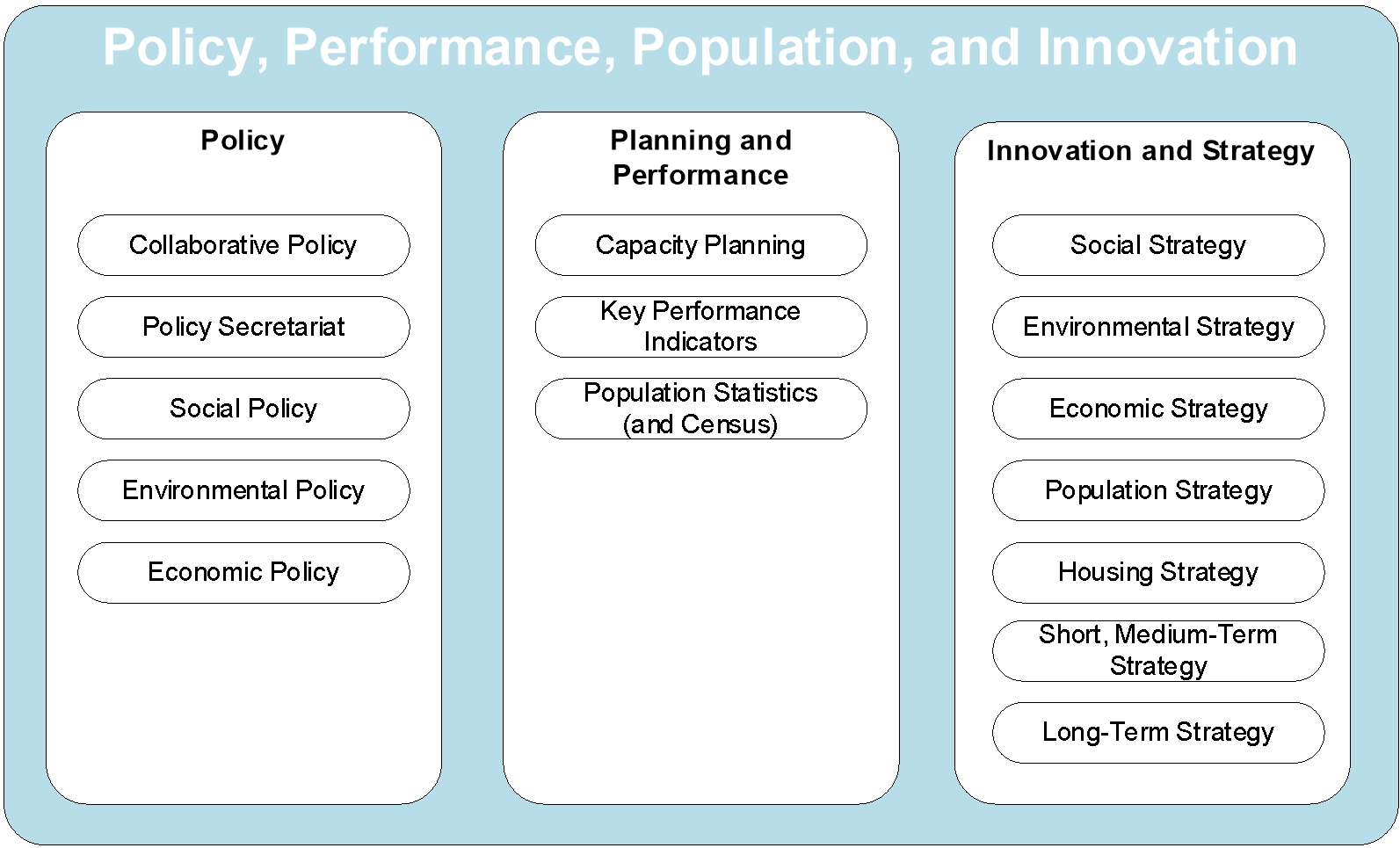
Figure 10: Structure and Content Overview of the L1-L3 Elements of the Proposed Policy, Performance, Population, and Innovation Sector
10.1 Policy, Performance, Population, and Innovation Taxonomy
|
Sector |
Function |
Service |
Description |
|
Policy, Performance, Population, and Innovation |
Policy |
Develops and assesses the sustainability of current programs and policies that pertain to the environment, society, economy, and marketplace. |
|
|
Collaborative Policy |
Refers to activities that monitor, manage, and respond to the wants and meets of the marketplace. |
||
|
Policy Secretariat |
Co-ordinates the analysis, needs assessment, and initiation of the drafting of strategic documents to establish public policies and streamline policy procedures. |
||
|
Social Policy |
Refers to activities, guidelines, principles, and legislation administered by the government to reduce inequality and ensure adequate welfare. |
||
|
Environmental Policy |
Encompasses activities, guidelines, principles, and legislation administered by the government in order to minimize the environmental effects of society. |
||
|
Economic Policy |
Encompasses activities, guidelines, principles, and legislation administered by the government in order to analyze economic stability and growth. |
||
|
Planning and Performance |
Refers to the continuous process of identifying and planning the best way to reach goals. |
||
|
Capacity Planning |
Refers to activities used to determine the maximum amount of change and production capacity the government has available in order to meet planning requirements. |
||
|
Key Performance Indicators |
Measures outcomes and activities to ascertain the success of the government by achieving strategic objectives and determining improvement criteria. |
||
|
Population Statistics (and Census) |
Comprises generating population statistics and census, including monitoring population trends and benchmarks to inform research, policy-making, and planning. |
||
|
Innovation and Strategy |
Refers to plans, initiatives, and activities used to achieve goals, address unmet market needs, and utilize emerging technology to do so. |
||
|
Social Strategy |
Refers to plans, initiatives, and activities used to achieve social goals and address social inequalities. |
||
|
Environmental Strategy |
Refers to plans, initiatives, and activities used to achieve environmental goals and tackle climate change. |
||
|
Economic Strategy |
Refers to plans, initiatives, and activities used to achieve economic goals and enhance performance through more efficient allocation and utilization of resources. |
||
|
Population Strategy |
Refers to plans, initiatives, and activities used to achieve population goals and address risks. |
||
|
Housing Strategy |
Refers to plans, initiatives, and activities used to achieve housing goals and promote flexibility and affordability of housing. |
||
|
Short, Medium-Term Strategy |
Comprises the determination of annual and near-terms goals and the identification of the best method to achieve goals. |
||
|
Long-Term Strategy |
Comprises the determination of strategic goals and the identification of the best method to achieve goals. |
||
10.2 Key Drivers for Change
Several factors are driving change in the sector, whereby the government will need to consider the points below.
Respond to Demographic Changes
Ageing population due to declining worldwide fertility rates is having a significant effect on policy. This will reduce the number of individuals of working age, increase dependency on social care, and result in reductions in the growth rate of potential output and the natural rate of unemployment.
Changes in population composition will also result in changes in social preferences, consequently affecting strategic goals, KPIs, and subsequently impacting long-term strategy.
Automate and Innovate
To make the workplace more competitive and counteract the decline in working population, there is increased pressure to use technology. Digital governments will soon be able to leverage open networks in the “cloud” to communicate and develop new ideas and applications. Cognitive computing and such mechanisms can subsequently collect, distribute, and access vast amounts of data that can assist government leaders to make better decisions, and enable government accountability, social inclusiveness, and partnerships.
Adopt New Economic Metrics
The traditional metrics that guide national policies and corporate investments focus narrowly on short-term financial value. As social values diverge, there is growing misalignment between businesses and governments that foments critical policy failures including inequality, climate change, and falling living standards.
Incorporating a broader set of “social” metrics, such as hours worked, will dramatically change our understanding of the economy. Many groups are developing new metrics as social pressures stimulate a government response; for example, the United Nations supports a dashboard approach to measuring wellbeing.
These changes to perceptions of strategic goals will subsequently have significant impacts on policy and strategy.
Shared Services co-ordinates and manages people, communications, finance, and transformation services on behalf of the public in order to facilitate the transfer of information and oversight of people, processes, and technology to support procurement and align to corporate strategy.
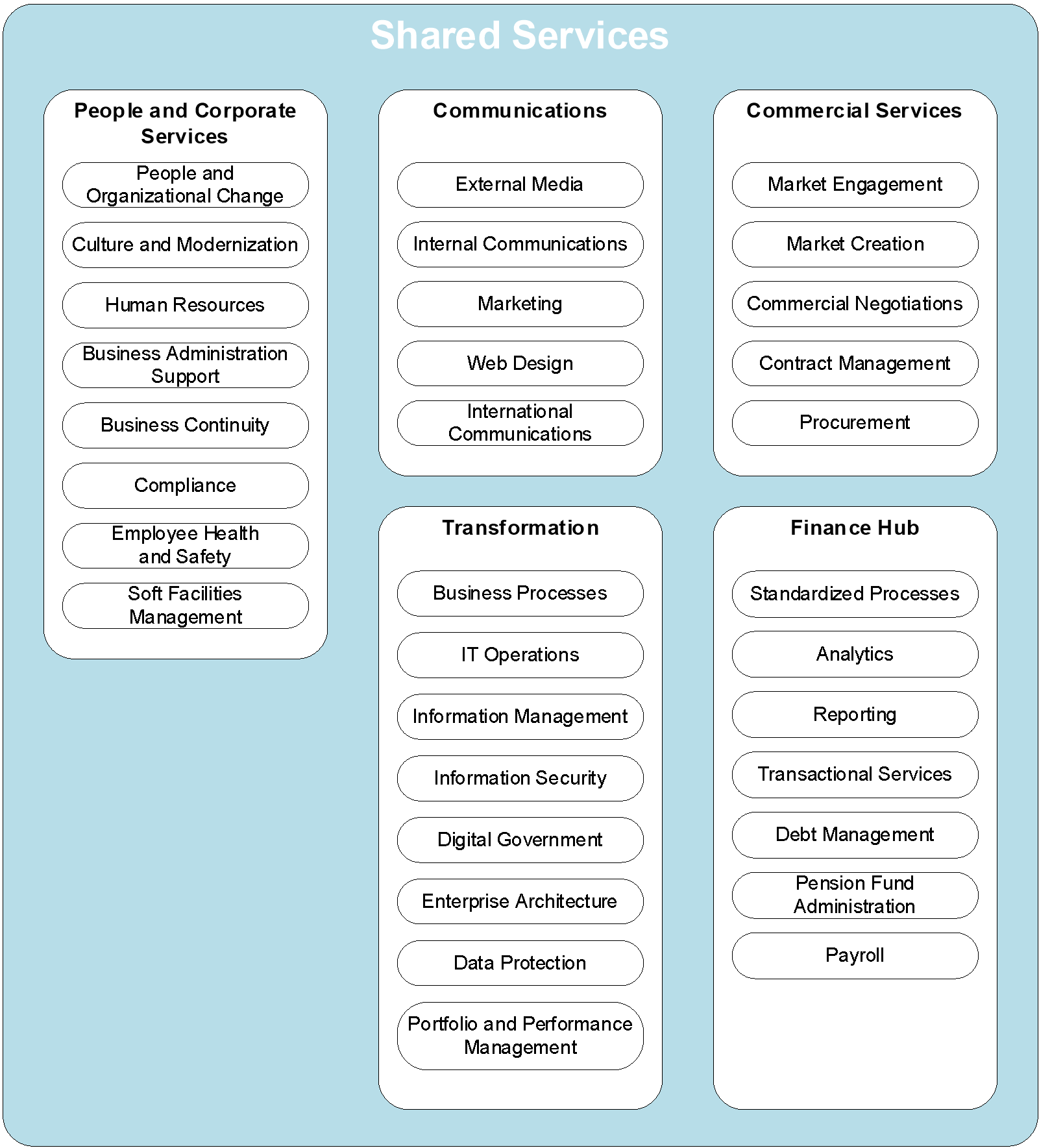
Figure 11: Structure and Content Overview of the L1-L3 Elements of the Proposed Shared Services Sector
11.1 Shared Services Taxonomy
|
Sector |
Function |
Service |
Description |
|
Shared Services |
People and Corporate Services |
Activities that combine or consolidate people and enterprise-wide needed support services. |
|
|
People and Organizational Change |
Encompasses the processes that surround altering the government’s strategy, processes, culture, and technology. |
||
|
Culture and Modernization |
Refers to activities used to update people services and manage employee culture. |
||
|
Human Resources |
Refers to activities associated with the management of employees including hiring, training, and communication. |
||
|
Business Administration Support |
Refers to all activities that involve overseeing and supervising business operations. |
||
|
Business Continuity |
Involves the creation of systems in order to deter potential threats. |
||
|
Compliance |
Refers to the direct monitoring and oversight of people guidelines and regulations. |
||
|
Employee Health and Safety |
Consists of activities used to design, develop, and implement employee health and safety programs. |
||
|
Soft Facilities Management |
Refers to the management of non-essential facilities to make the workplace more comfortable and enjoyable. |
||
|
Communications |
Growth, provision, and management of information, regulation, and media services to support the provision of communication services. |
||
|
External Media |
Refers to the movement of information between the government and the external environment. |
||
|
Internal Communications |
The regulation, growth, and management of industries that enable the transmission of information to domestic citizens. |
||
|
Marketing |
The provision of content and presentation of marketing material distributed through any medium. |
||
|
Web Design |
Refers to the design of interactive web content. |
||
|
International Communications |
The regulation, growth, and management of industries that enables the transmission of information abroad. |
||
|
Commercial Services |
Activities related to sourcing, managing, and procuring contracts with vendors, suppliers, partners, and third parties to enable the development of new projects and opportunities. |
||
|
Market Engagement |
Refers to the activities by which the government engages with suppliers prior to procurement of a project. |
||
|
Market Creation |
Refers to the elimination of trade barriers and provision of property rights to allow the development of a market for a good or service. |
||
|
Commercial Negotiations |
The identification, management, and conduct of strategic discussions to develop new opportunities. |
||
|
Contract Management |
The creation, execution, and analysis of contracts with partners and suppliers. |
||
|
Procurement |
Refers to the assessment of risk, evaluation of alternative options, award of contract to a supplier. and ongoing management of contracts for a product or service. |
||
|
Transformation |
The complete reassessment and overhaul of a function. |
||
|
Business Processes |
Refers to the monitoring, assessment, and enhancement of existing business processes, activities, and functions. |
||
|
IT Operations |
Comprises processes and services administered by the IT department. |
||
|
Information Management |
Refers to activities that facilitate collection and migration of data and information. |
||
|
Information Security |
Refers to the protection of information and systems from unauthorized access, use, modification, or destruction. |
||
|
Digital Government |
Refers to the use of information and technology to provide digital offerings. |
||
|
Enterprise Architecture |
Activities used to define current, transition, and target strategies for an organization’s processes, people, and technology. |
||
|
Data Protection |
Activities associated with the protection, collection, compliance, and distribution of personal data. |
||
|
Portfolio and Performance Management |
Supports the administration and effectiveness of investments and assets held by the government. |
||
|
Finance Hub |
Financial center whereby a large number and variety of financial services institutions are headquartered. |
||
|
Standardized Processes |
Establishes a set of validated and accepted procedures that define appropriate and reliable practices. |
||
|
Analytics |
All forms of data analysis from extremely large, complex data sets (Big Data) that are manipulated through to sparse rare-occurrence data. |
||
|
Reporting |
Includes provision of financial information, reporting, and analysis of financial transactions. |
||
|
Transactional Services |
Oversees business transactions and deals such as mergers or acquisitions. |
||
|
Debt Management |
The process of establishing and executing a strategy for managing debts, achieving risk and cost objectives, and meeting any other debt management goals set. |
||
|
Pension Fund Administration (PFA) |
Responsible for opening Retirement Savings Accounts (RSA), the payment of retirement benefits, and accounting for all transactions relating to pension funds. |
||
|
Payroll |
The total compensation to be paid to employees for a set period of time. |
||
11.2 Key Drivers for Change
Shared Services will also change influenced by common drivers that the government will need to consider.
People Reform
To meet new demands and public sector needs, there is a requirement for changes in the composition of the workforce through modernizing people acquisition, training, and retention. Intellectual property is also the differentiating and competitive factor in the public sector. With shortages in younger, tech-savvy staff, training is therefore key, including in the public sector.
Digitalization
Advances in cognitive computing and blockchain can be leveraged to increase customer interactions and increase personalized services in order to tackle more complex problems and improve customer self-service. Virtual assistants can also be utilized in order to allow staff to focus on challenging tasks, leading to an increase in user experience and satisfaction across the board.
Blockchain can be used to manage data and digital assets, and create a digital audit trail which can subsequently be used to optimize supply chains, improve procurement, and maintain employment, deeds, and suchlike records.
Enhance Technology Capabilities
Digitization increases the ability to enable collaboration between functions and sharing of important information. This will enable the potential for a significant increase in efficiency with the help of digital tools.
This will include embracing the following technologies:
- Next-Generation ERP Systems: procuring these will enable governments to create holistic and improved customer experience across front and back-office processes
- Automation AI, RPA, and Automation: reduce the amount of manual work and remove the administrative burden from employees so they can focus on functional priorities
- Cloud: the cloud enables customer services and operations to be more dynamic and flexible – enhancing the ability to test new projects that are cost-effective and low-risk and allowing the government to use technology to meet customer demands more quickly
Transport and Operations includes activities that enable general operations including maintenance and general management, and guarantee the safe transfer and availability of people and goods over land, air, sea and space.
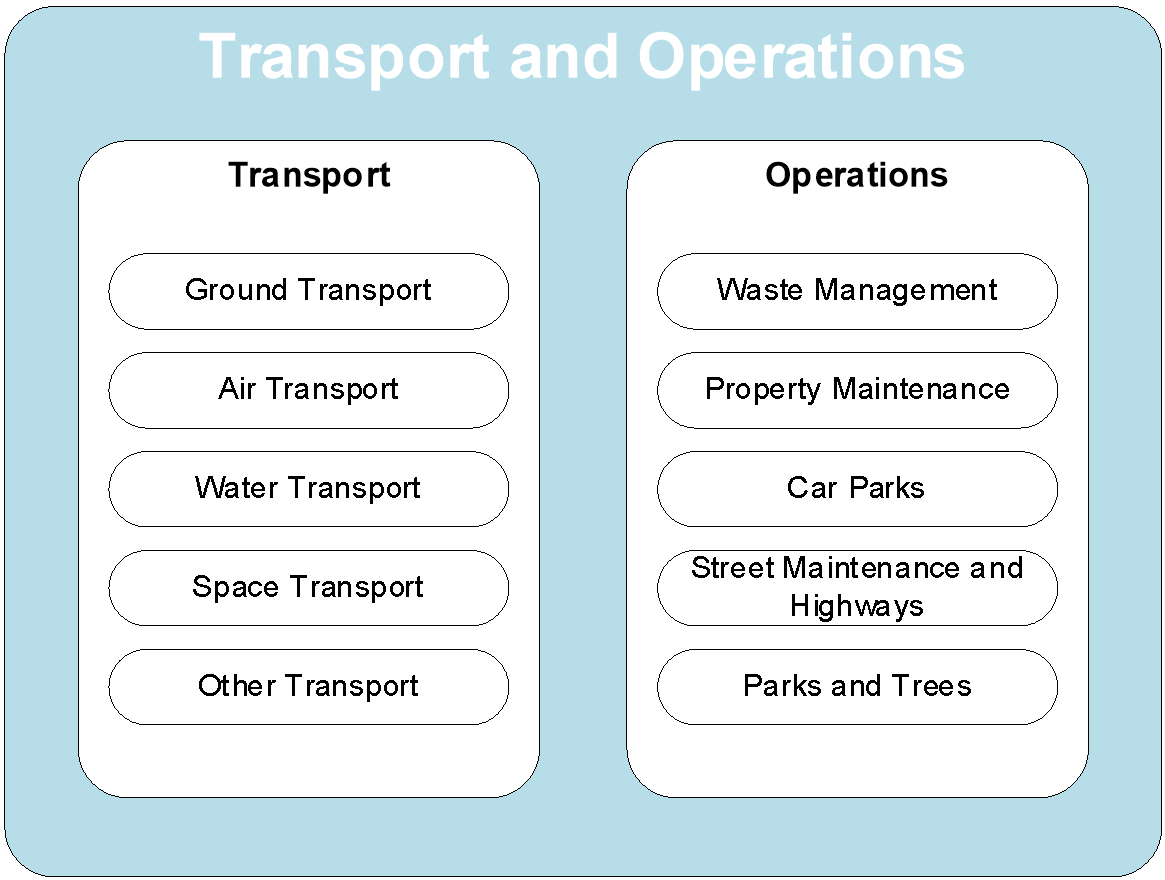
Figure 12: Structure and Content Overview of the L1-L3 Elements of the Proposed Transport and Operations Sector
12.1 Transport and Operations Taxonomy
|
Sector |
Function |
Service |
Description |
|
Transport and Operations |
Transport |
Activities pertaining to the safe transfer and availability of people and goods over land, air, sea, and space. |
|
|
Ground Transport |
Involves the activities to ensure safe transfer and availability of people and goods over land. |
||
|
Air Transport |
Involves the activities to ensure safe transfer and availability of people and goods through air. |
||
|
Water Transport |
Involves the activities to ensure safe transfer and availability of people and goods over water. |
||
|
Space Transport |
Involves the activities to ensure safe transfer and availability of people and goods in space. |
||
|
Other Transport |
Involves all other movement of people and goods not covered by land, air, water, and space through latitude and longitude. |
||
|
Operations |
Activities pertaining to the maintenance and general management of waste, public property, greenery, parking facilities, and streets. |
||
|
Waste Management |
Corresponds to the disposal, recycling, monitoring, collection, or movement of waste. |
||
|
Property Maintenance |
Refers to ensuring the security, upkeep, and maintenance buildings and properties owned by the government. |
||
|
Car Parks |
Refers to ensuring the security, upkeep, and maintenance of public car parks. |
||
|
Street Maintenance and Highways |
Refers to the repair, upkeep, and maintenance of roads, footways, and highways. |
||
|
Parks and Trees |
Refers to the maintenance, planting, and conservation of trees and greenery in national parks, public parks, and conservation areas. |
||
12.2 Key Drivers for Change
For the Transport and Operations sector, effective mobility in cities remains a critical enabler for productivity, economic growth, and sustainability.
The factors described below will be considered as drivers.
Public Opinion
Governments must respond to changes in public opinion towards climate change that will drive innovation and prompt greater focus on alternative fuels, energy availability, and global responses. There is also an expectation that vehicle emissions will drop as alternative fuels and energy sources emerge.
Policy
With increasing scrutiny on spending, governments are looking more closely at transportation infrastructure delivery and investment. The future of transport and regulation will look to:
- Enable innovation without compromising safety and overall productivity
- Remove barriers to entry for mobility service providers
- Use behavioral economic advisory to help design and implement policies more effectively
Smart Mobility
Intelligent mobility can be encouraged through autonomous vehicle technology whereby digital solutions and Big Data will be utilized to provide useful real-time information to journey makers including journey planning, route optimization, navigation, schedules, and performance reviews. This information can also be leveraged by government bodies to manage and adjust demand on busy roads by using demand-based pricing during peak times.
The GRM provides public sector organizations with a common framework and methodology to plan and execute change. The 11 sectors provide a view by which government organizations can segment departments to facilitate the identification of change impacts and map dependencies. The drivers for change provide a view of common themes within the government and can be leveraged to inform overall outcomes.
Ultimately. this document provides direction to develop Business Architecture assets that will help public sector decision-makers to resolve problems, manage change, and enable effective future planning.
This appendix provides an overview of the structure and content of the L1-L3 elements of the proposed GRM across the 11 sectors.
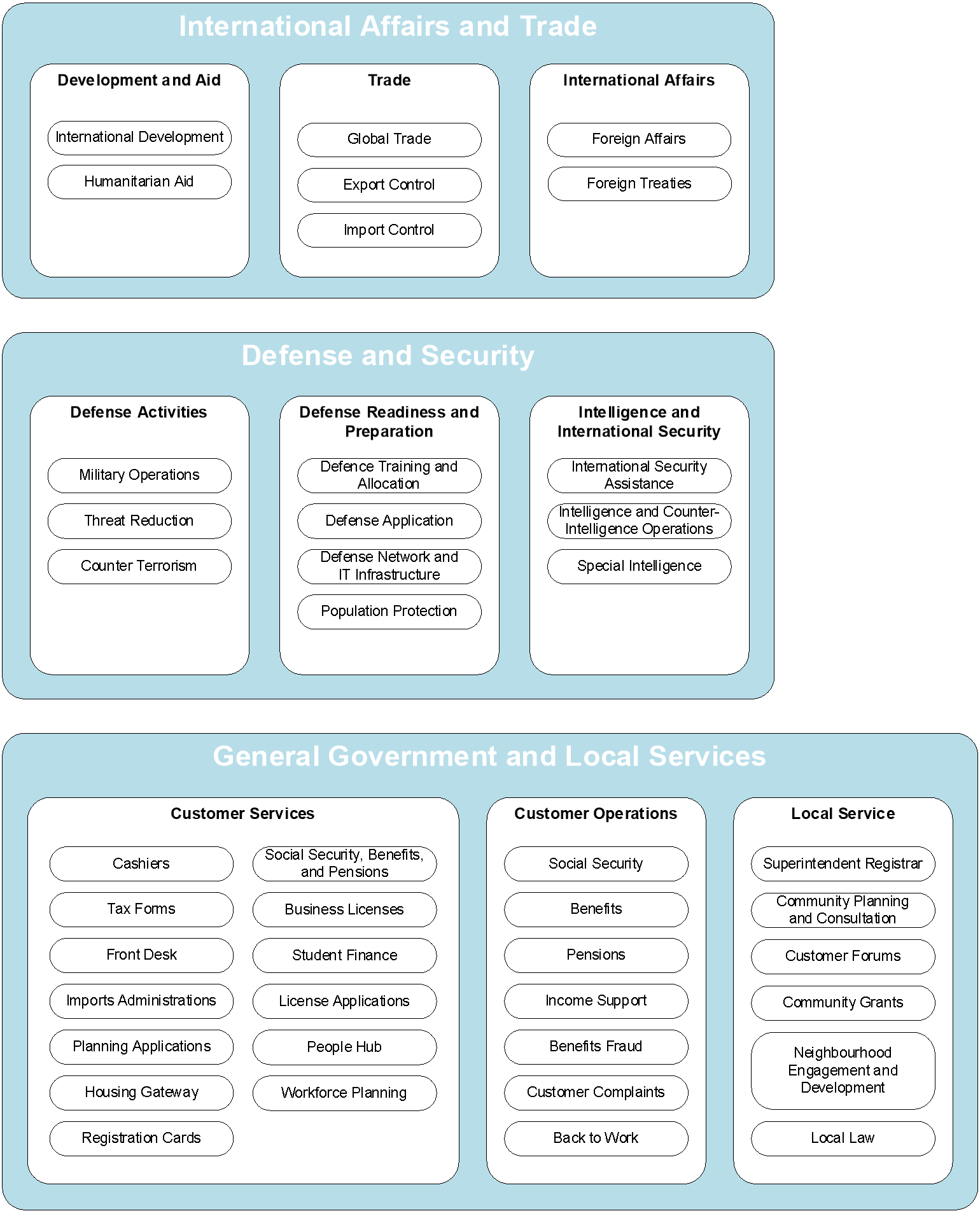
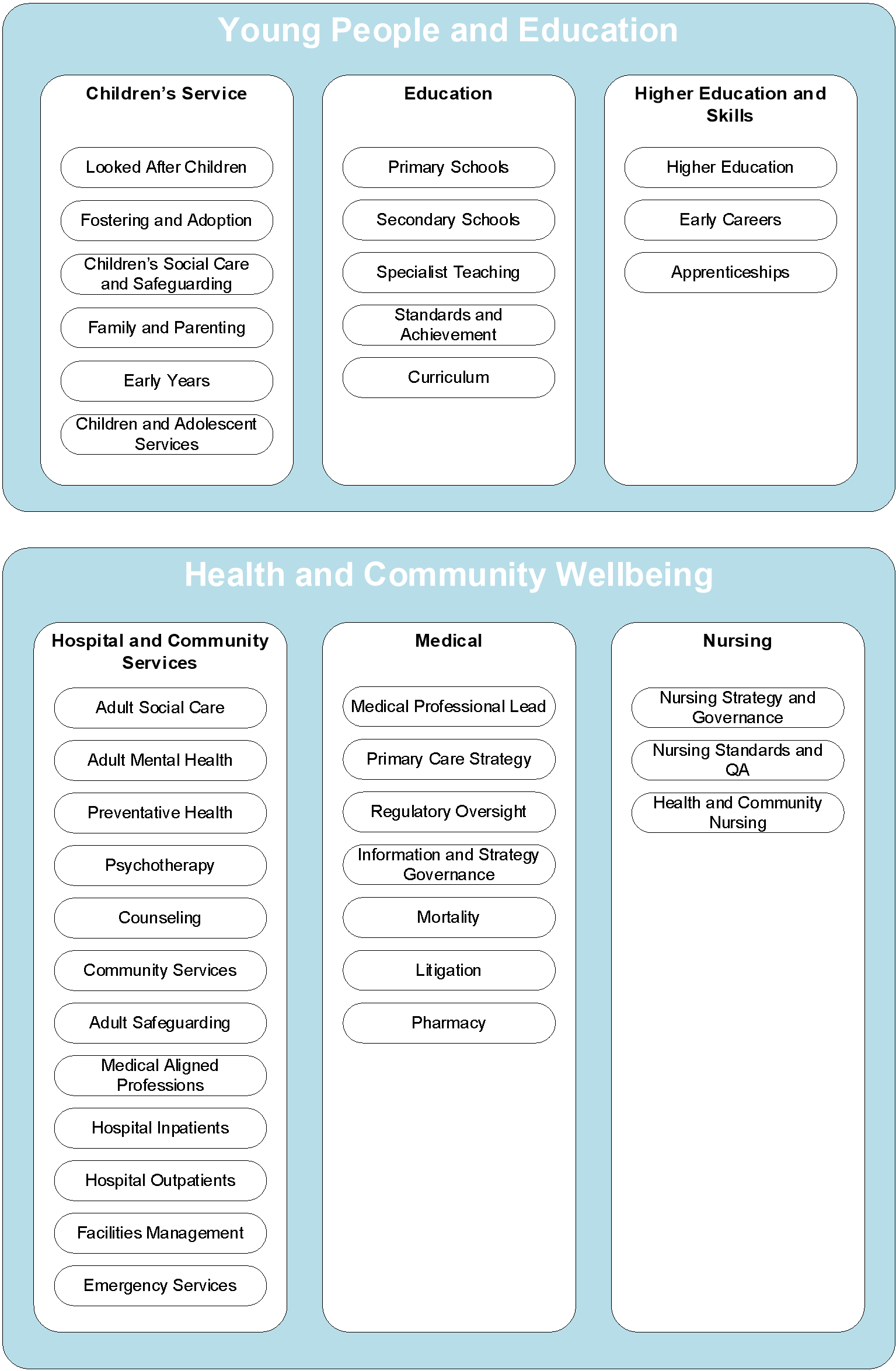
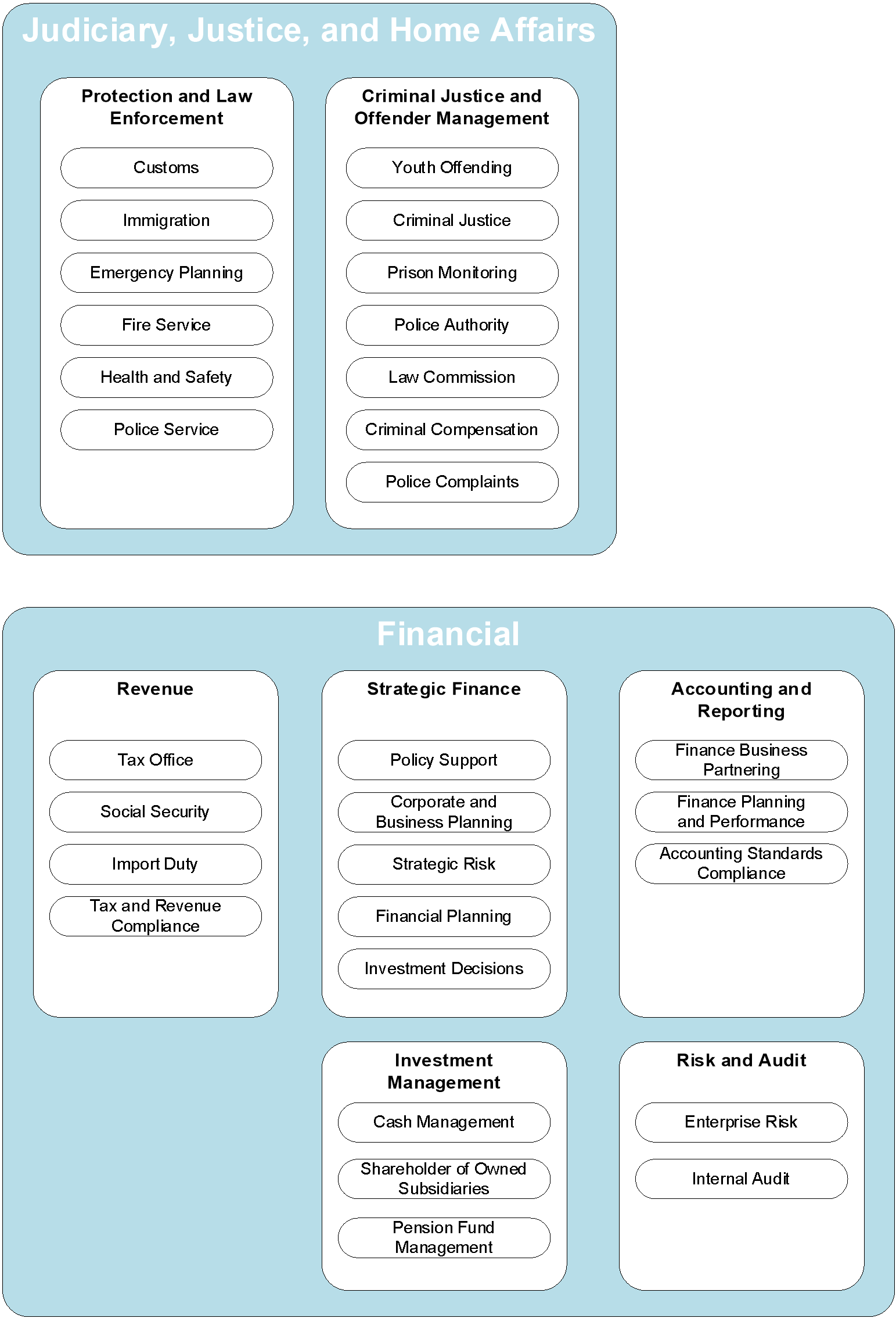
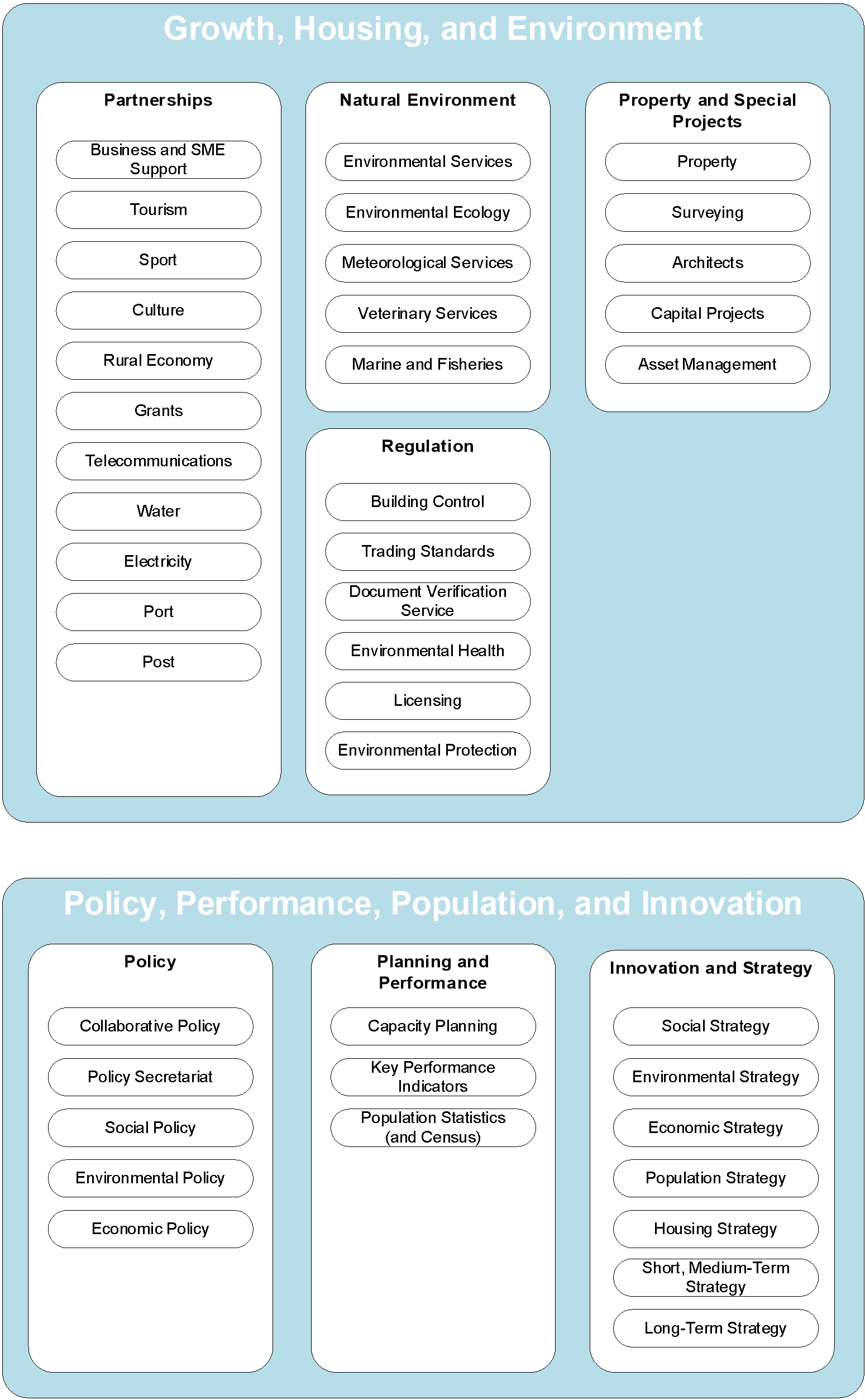
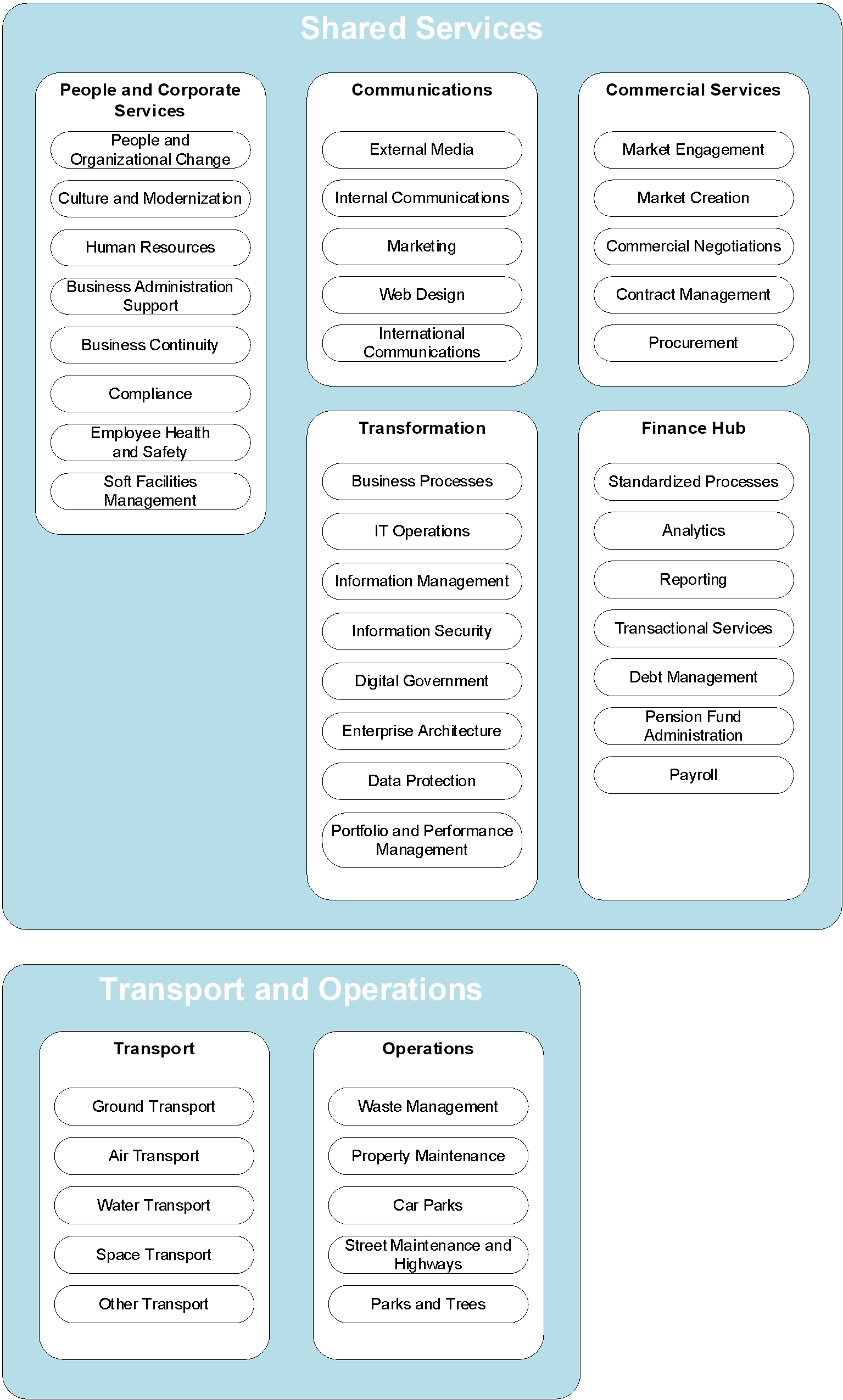
Acronyms & Abbreviations
ABB Architecture Building Block
AI Artificial Intelligence
DMaSC Defence Modeling and Simulation Coherence (British Army)
ERP Enterprise Resource Planning
GRM Government Reference Model
IoT Internet of Things
KPI Key Performance Indicator
PFA Pension Fund Administration
RPA Robotic Process Automation
RSA Retirement Savings Account
SCTA Service Command Technical Authority (British Army)
VR Virtual Reality
Footnotes
[1] Refer to https://ec.europa.eu/ and https://www.e-codex.eu/.

 return to top of page
return to top of page